Maine is an incredible state, boasting fantastic wildlife and bird life.
From the rocky Atlantic coastline to the beautiful mountains, Maine is home to stunning birds and animals.
Whether you are visiting “Vacationland” or live in the state, you have limitless opportunities to interact with and enjoy the birds here.
Spotting and identifying ducks can be a fun pastime for new and experienced birders. Most ducks are migratory, and their appearance may change from breeding season to winter.
There are a handful of ducks who live year-round in the state, although most are winter residents. A small number only stay for the summer.
Most ducks are sexually dimorphic, so you have to learn to identify the male and female of each species as well!
If you want to learn to identify ducks in Maine, you will have a fun and rewarding challenge ahead of you!
We have put together a list of 32 ducks who live in or visit Maine. Before we get started, let’s take a look at the differences between the types of ducks and how to spot them.
Tips & Tricks to Identify Ducks
Our list does more than just give you the names and locations of ducks. We are also providing pictures, descriptions, and details about their unique behaviors.
When identifying ducks, you will want to look for the following features:
- Size (weight, length, and wingspan)
- Colors
- Feather patterns
- Unique behaviors and habits
- Habitat (which usually changes from summer to winter)
- Diet
- Silhouette (shape)
Dabbling and Diving Ducks
Ducks can be divided into two main categories: dabbling ducks and diving ducks.
Dabbling ducks tuck their heads under the water to gather food, but they do not submerge the rest of their bodies. They may just dip their bills into the water, or they will flip upside-down and leave their tails pointing toward the sky.
Diving ducks submerge themselves completely underneath the water to get food from deeper waters. Most ducks dive for about 10-30 seconds, although some can dive for around a minute. Long-Tailed Ducks will even dive for up to 2 minutes!
Sea Ducks are a special category of diving ducks. They dive for their food, and they live almost exclusively in seawater.
The category of tree duck is somewhat outdated, but it is still a useful label for ducks that tend to perch in trees. We’ve included a few of these on our list, too!
We have labeled each duck as a dabbling duck, diving duck, or sea duck. Just remember that sea ducks are also diving ducks!
American Black Duck (Dabbling Duck)
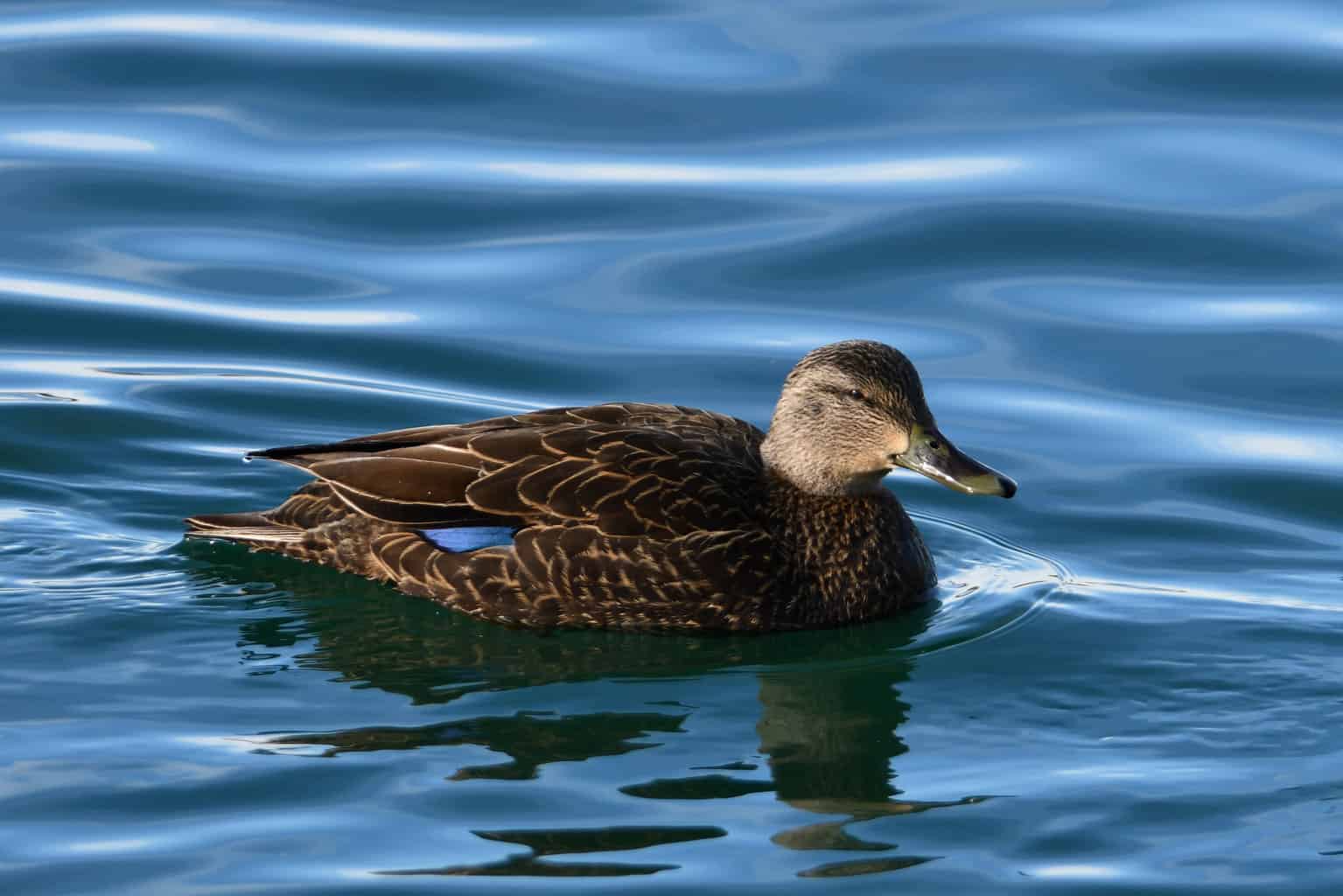
- Anas rubripes
- Length: 21.3-23.2 inches
- Weight: 25.4-57.9 ounces
- Wingspan: 34.6-37.4 inches
American Black Ducks are incredibly common breeding-season residents of Maine. In fact, there are more breeding American Black Ducks in Maine than there are in any other state. Their numbers are similar in the Canadian province of Nova Scotia.
Some Black Ducks will stay year-round along Maine’s Atlantic Coast, too.
To identify the male American Black Duck, look for his dark brown body and his bright blue speculum. The speculum is the bar of color on the secondary feathers of a duck’s wings. It is most visible when the duck is in flight.
Male Black Ducks are sometimes mixed up with female Mallards, as their patterning is similar. However, the Black Duck has a yellow bill, whereas the Mallard’s bill is orangeish-gray.
Females look similar to males, but their feathers are lighter brown. The female’s bill is green.
Tree removal is affecting the habitat of American Black Ducks. They inhabit wooded marshes, bays, rivers, ponds, and lakes, usually nesting in abandoned tree cavities.
American Wigeon (Dabbling Duck)

- Mareca americana
- Length: Up to 14 inches
- Weight: About 2.25 pounds
- Wingspan: 34 inches
American Wigeons are not common in Maine, but there have been a number of sightings during the breeding season. You are more likely to see them during their migration window. Their summer habitat includes inland marshes. They prefer larger bodies of water to smaller ones.
Male American Wigeons have an iridescent green band on their face. It starts at the eyes and swoops down toward the back of the head.
The male has a light brown body, black tips on his wings, and a black tail. His bill is blueish-gray and is tipped in black.
Females have light brown coloring with a dappled gray head. Her eyes are dark, and she has a black-tipped bill, as well.
Barrow’s Goldeneye (Diving Duck)
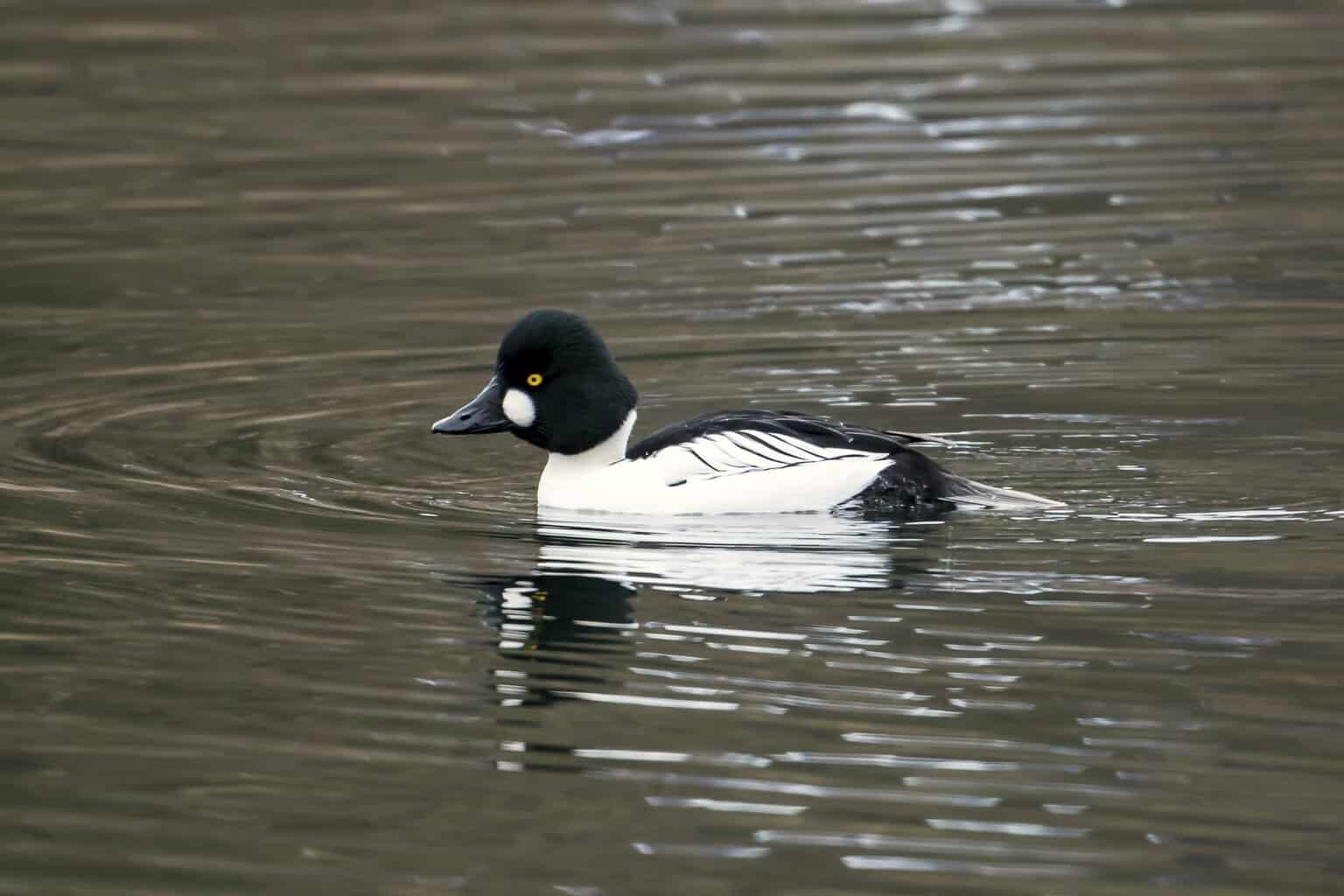
- Bucephala islandica
- Length: 16 – 20 in (41 – 51 cm)
- Weight: 38.4 oz (1088 g)
- Wingspan: 30 – 32 in (76 – 81 cm)
Barrow’s Goldeneyes in Maine are endangered and protected by law. There is no time of year when it is legal to hunt Barrow’s Goldeneyes in Maine, which is why it is so important for duck hunters to be able to differentiate between Barrow’s and Common Goldeneyes.
There may be fewer than 250 individual Barrow’s Goldeneyes in Maine.
If you want to see one, your best bet is to go to one of the following known winter habitats: between Skowhegan and Richmond on the Kennebec River; between Old Town and Bucksport on the Penobscot River; between Trenton and Lamoine Beach on the Mt. Desert Narrows; below Thomaston on the St. George River; and near Freeport on the Harraseeket River.
They are also found in Belfast Bay, Englishman Bay, Carver’s Harbor in Vinalhaven, and Salt Pond near Blue Hill.
Male Barrow’s Goldeneyes have a head that is such a dark shade of purple that it looks more like black from a distance. His most distinctive feature is the white crescent you will find on his cheek. He has a black bill and a row of square-ish white spots on his otherwise black wings.
Females have a dark gray body, brown head, and a white ring around the neck. The female’s bill is orangeish-yellow.
Males and females alike have golden-yellow eyes.
They avoid waters that are full of fish that eat insects because those fish would end up being competition for the Barrow’s Goldeneye.
Black-Bellied Whistling Duck (Tree Duck/Dabbling Duck)
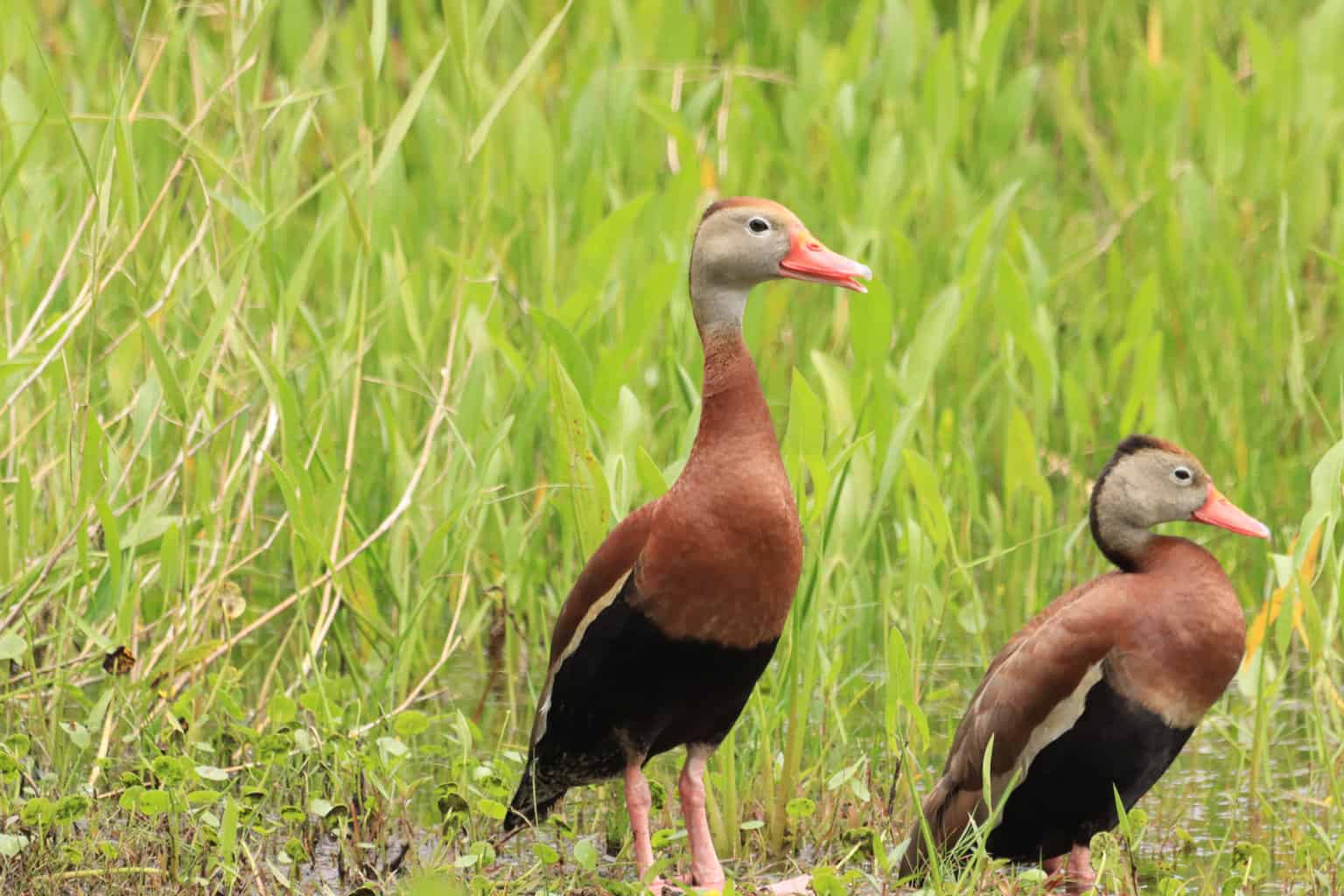
- Dendrocygna autumnalis
- Length: 19 – 22 in (47 – 56 cm)
- Weight: 652 – 1020 g (1.437 – 2.249 lb)
- Wingspan: 30 – 37 in (76 – 94 cm)
Maine sees very few Black-Bellied Whistling Ducks in the state, but they have been confirmed here and have earned a spot on this list!
They were first documented in 2010, and there have been 4 total sightings. In April 2022, a flock of 11 Black-Bellied Whistling Ducks was observed in Camden.
Black-Bellied Whistling Ducks are unusual in that they are sexually monomorphic instead of dimorphic. Females and males look the same: dark brown breast, gray head, small and dark brown crest, gray face, pink bill, and black belly.
They spend a lot of time perching in trees, which is what gives them their previously-used title of “tree duck.”
Black Scoter (Diving Duck)
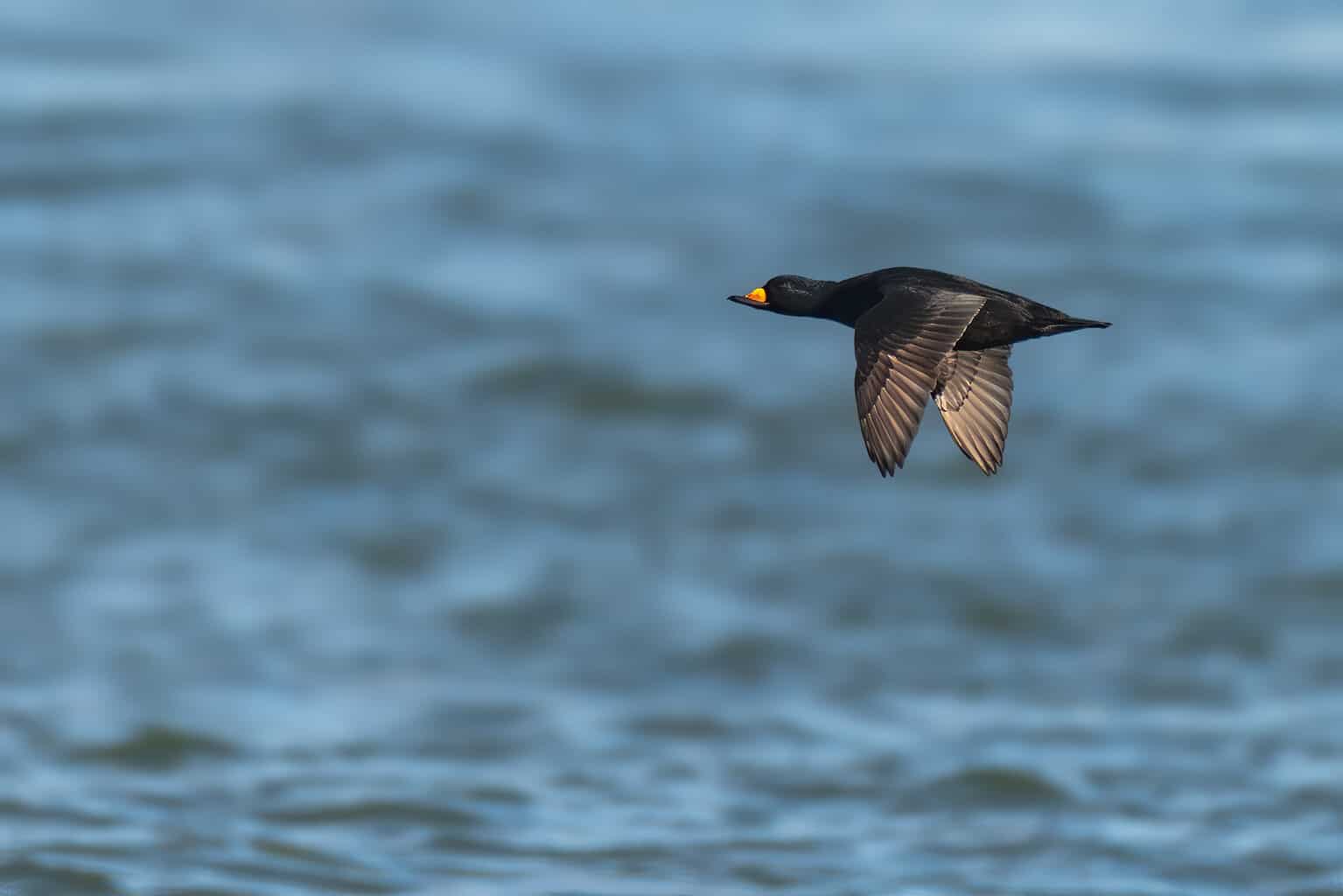
- Melanitta Americana
- Length: 127 – 21 in (43 – 53 cm)
- Weight: 387.4 oz (1088 g)
- Wingspan: 30 – 35 in (76 – 89 cm)
Black Scoters are just one of the three kinds of scoters that spend the winter in Maine. Surf Scoters and White-Winged Scoters show up later in our list. Note that Black Scoters were once referred to as Common Scoters.
Their winter territory includes the Pacific and Atlantic Coasts. The ones you see in Maine will have migrated from Quebec.
Black Scoter males have a distinctive feature that sets them apart from most other ducks: their bill. They have a bulbous orange bulge at the base of their mostly black bill. The rest of him is black, too, including his body, eyes, and wings.
Females, on the other hand, are light brown. Their pattern is mottled, and they have a dark brown crown atop their head. The female’s cheeks are gray, and she has an all-black bill.
Blue-Winged Teal Duck (Dabbling Duck)
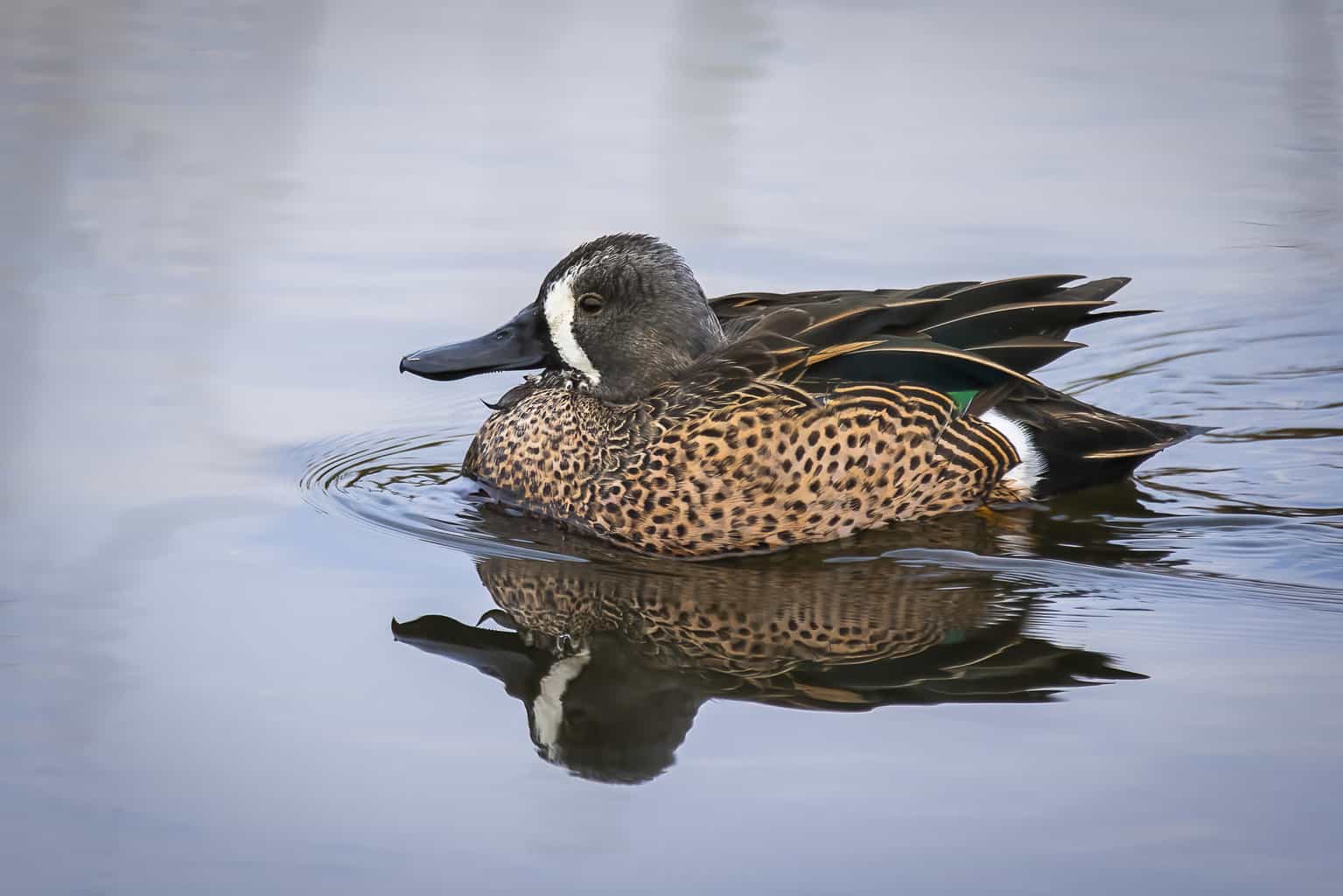
- Spatula discors
- Length: 15 – 17 in (38 – 43 cm)
- Weight: 19.18 oz (544 g)
- Wingspan: 23 -31 in (58 – 79 cm)
Much of Maine serves as a hospitable environment for Blue-Winged Teal Ducks to nest and breed in the summertime. They don’t necessarily live on the coast, but they do stay closer to the coastal part of Maine rather than the mountains in the northwest.
They prefer grassy habitats and calm ponds and marshes.
When you spot a male Blue-Winged Teal Duck, you will know him from his gray head, mottled brown body, black back, and the large white crescent shape in front of his eyes. He also has a screen speculum and a blue patch on his shoulders.
Female Blue-Winged Teal Ducks are speckled in brown. They lack the distinctive facial covers that the males have.
Unfortunately, Blue-Winged Teal Ducks have uncommonly high mortality rates. Although researchers are not entirely sure about the reasons for this, they suspect that it is related to their very long migrations.
Some individual Blue-Winged Teals will travel between Canada and South America when they migrate.
Bufflehead (Diving Duck)
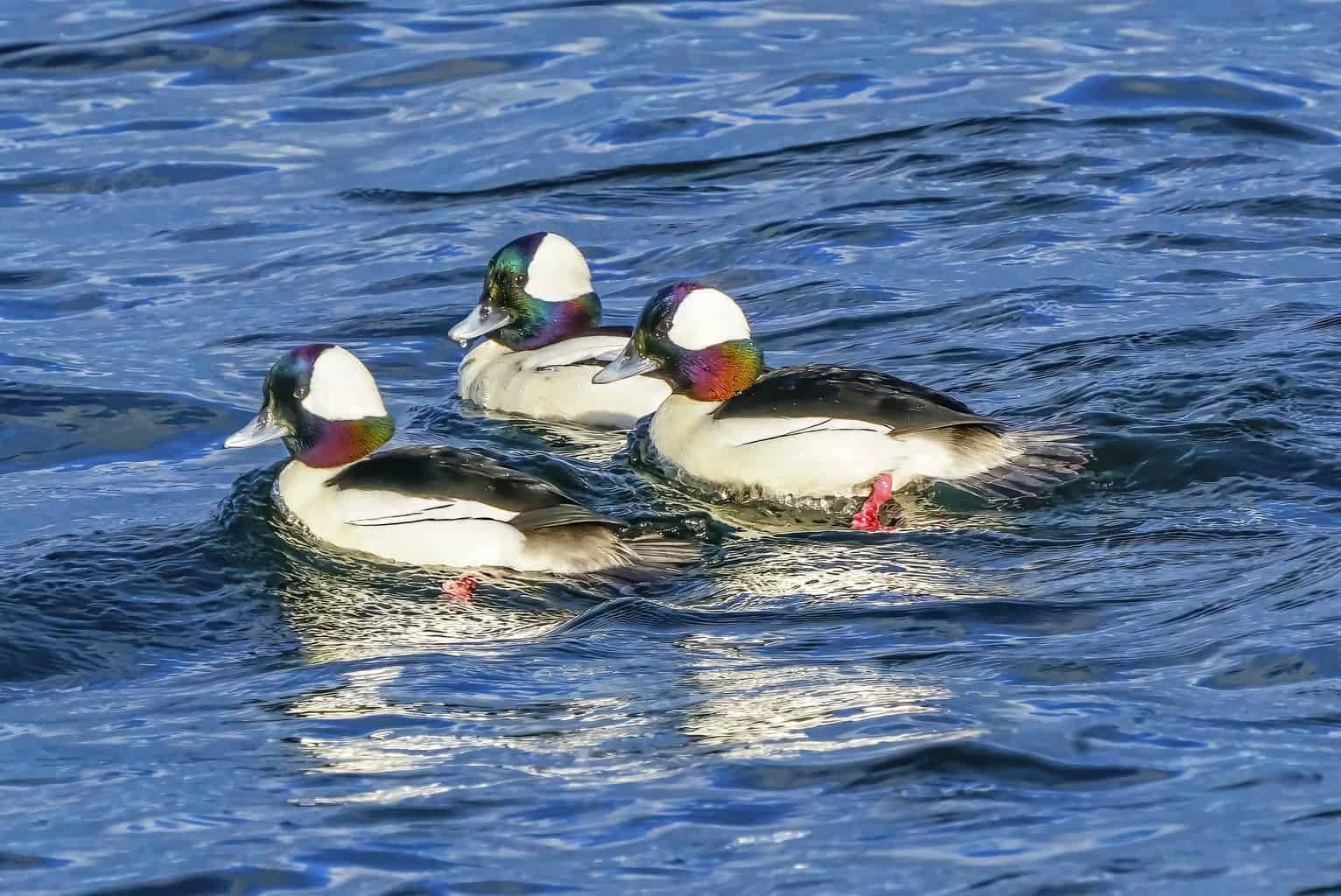
- Bucephala albeola
- Length: 13 – 16 in (33 – 41 cm)
- Weight: 21.16 oz (600 g)
- Wingspan: 22 in (55.8 cm)
Buffleheads migrate through northern and western Maine and spend the winter along the coast. Their preferred winter habitats include estuaries, sheltered coastal bays, and inland waters like ponds, rivers, and lakes.
They are cavity-dwellers who are also happy to inhabit nest boxes, which you can build on your own if you want to see more Buffleheads!
Buffleheads have large, rounded heads. The male Bufflehead’s slick, shiny iridescent green and purple head has a large, white, fan-shaped patch on it.
Females are brown and mottled, but they have white patches on their wings and cheeks. They have a grayish-white chest.
Because Buffleheads have legs that are set far back on their body, these small ducks are awkward on land. It can be fun to watch them on both land and water, as they are clumsy walkers and very active divers!
Canvasback (Diving Duck)
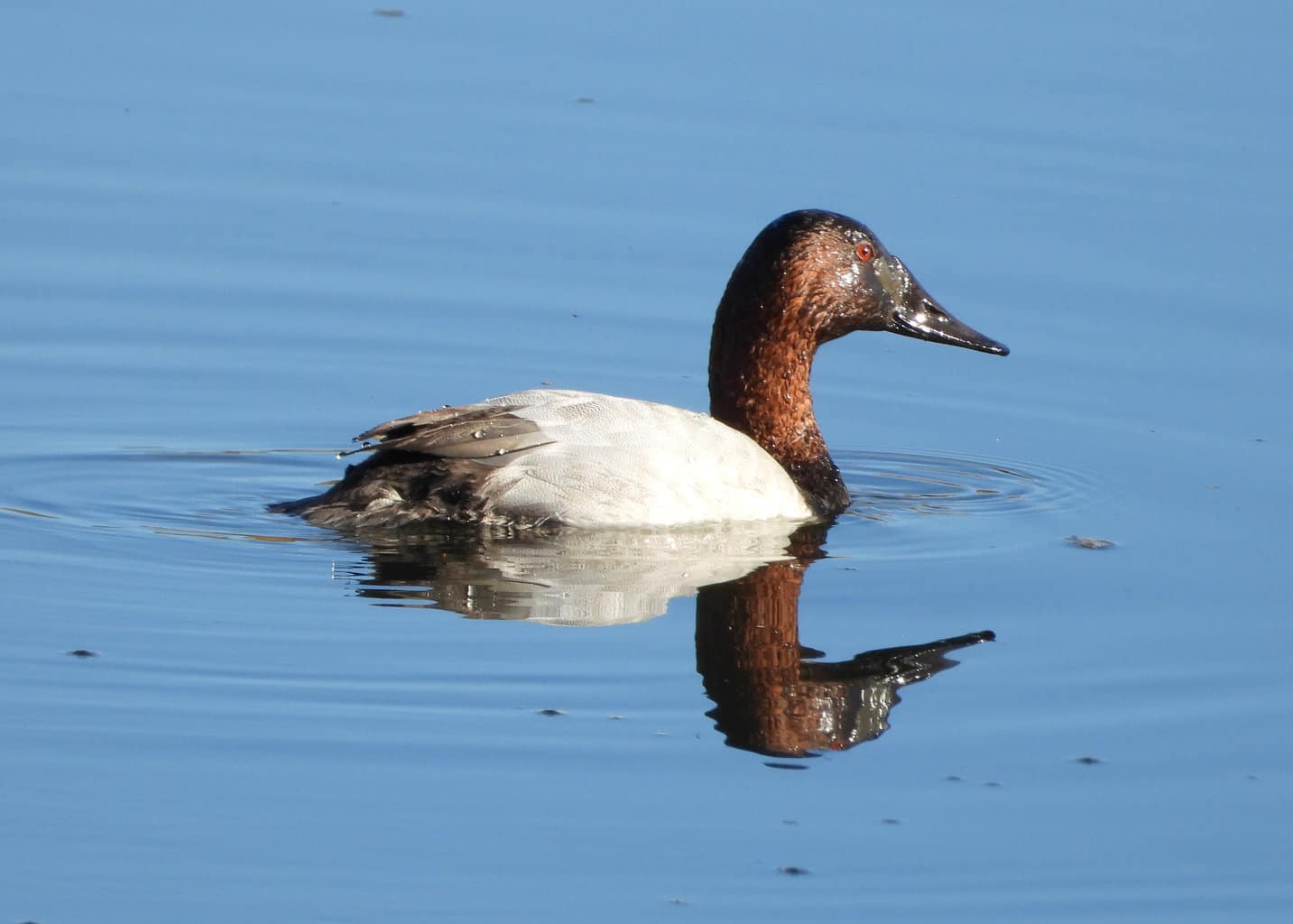
- Aythya valisineria
- Length: 19 – 24 in (48 – 61 cm)
- Weight: 58.48 oz (1657 g)
- Wingspan: 28 – 36 in (71 – 91 cm)
Canvasbacks are a rare sight in Maine — there are usually only a couple of sightings annually. The Damariscotta River was home to a single male who spent the whole winter there in 2018.
They are very large ducks. In fact, Canvasbacks are the largest diving ducks in North America!
You will quickly learn to identify the shape of the male’s sloping forehead, which is reddish-brown. The rest of his body is canvas-gray. He has a thick black bill, black tail feathers, and red eyes.
Females have black eyes, not red, but otherwise, their color pattern is similar to the male’s pattern. Though the pattern is the same, her coloring is much lighter.
Canvasbacks have a favorite food: wild celery, which grows in some of Maine’s lakes. They also eat other aquatic plants and grasses, as well as snails, clams, and other insects.
Common Eider (Sea Duck)
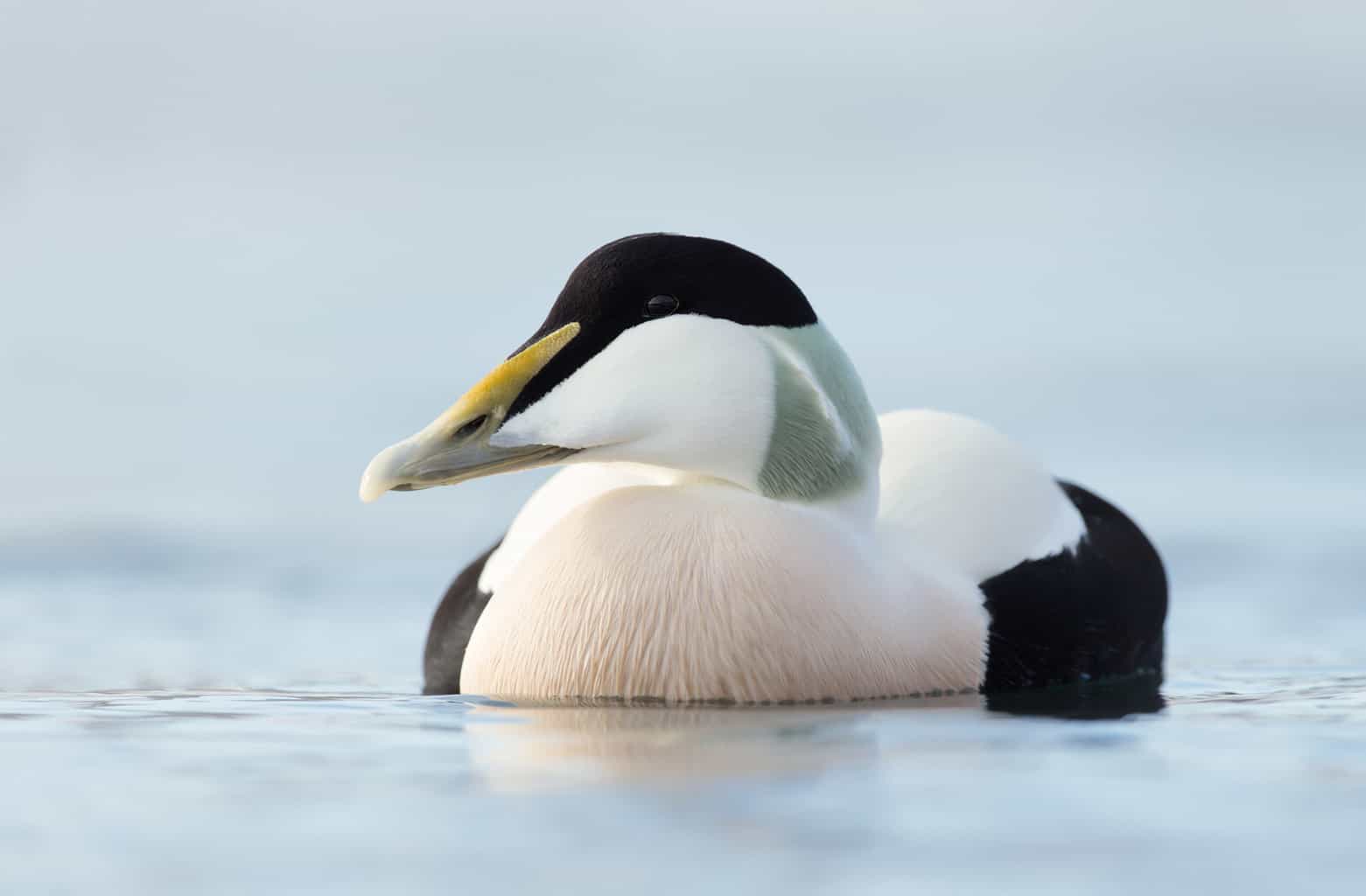
- Somateria mollissima
- Length: 19.7-28.0 in (50-71.1 cm)
- Weight: 45.9-92.1 oz (1300-2611 g)
- Wingspan: 37.4-38.6 in (95-98 cm)
Maine is the southernmost breeding range of the Common Eider, a large sea duck that can be found all the way to the Arctic Circle. They are common breeding-season residents of Eastern Egg Rock, off the coast of Boothbay Harbor.
Common Eider males are black and white with some light green on the back of the neck. Some males have a greenish bill, whereas others have a yellow-orange bill. His black crown extends down to just below his eyes. Before he reaches maturity, he will be brown (like the female) and have white patches all over his body.
Female Common Eiders are dark brown with a black barred pattern.
In the past, the down that females use to line their nests would be collected by humans to be used in clothes, pillows, coats, and other down items. Eiderdown is incredibly soft.
Today, however, Eiderdown is not collected in Maine. It is still collected in Canada and Iceland under strict international and national laws.
Common Goldeneye (Sea Duck)
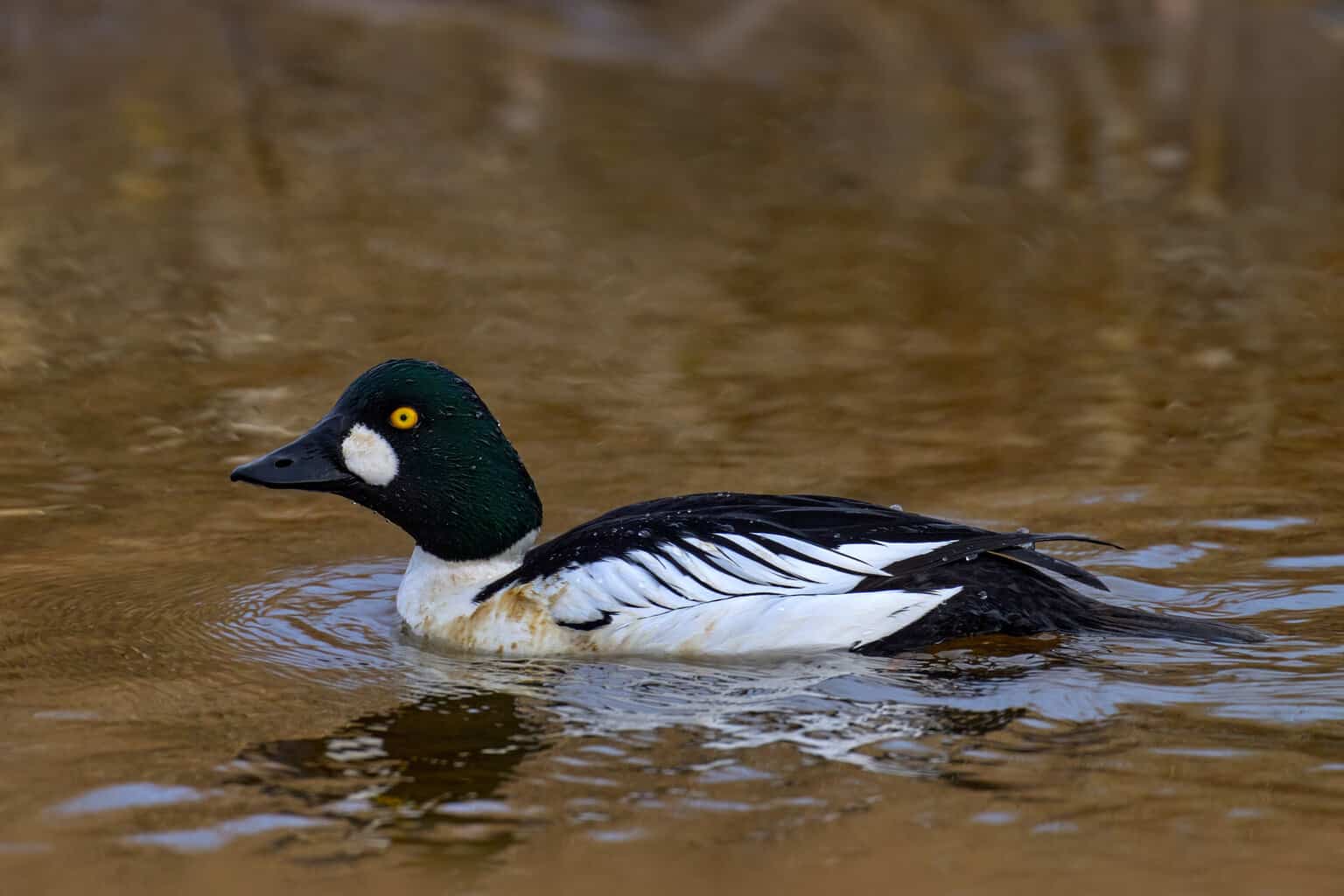
- Bucephala clangula
- Length: 16-20 inches
- Weight: Approximately 1.8 pounds
- Wingspan: 30.3-32.7 inches
Maine is home to Common Goldeneyes year-round. They are much more common than their relative, the Barrow’s Goldeneye. In the southwest corner of the state, they are more likely to be winter residents.
The male Common Goldeneye has an iridescent green head and a black and white body. He has white patches on his wings and yellow-gold eyes.
Females are brown with a yellow-tipped black bill. Her eyes are also yellow-gold.
Common Goldeneyes are aggressive ducks, even toward one another. Females are known for fighting during their nesting and breeding season, sometimes creating unintentional “creches.”
A creche occurs when a group of ducklings from different nests is raised together in one group. This happens with Common Goldeneyes after the females fight and the ducklings scatter, then find their way to a new nest.
Common Merganser (Sea Duck)
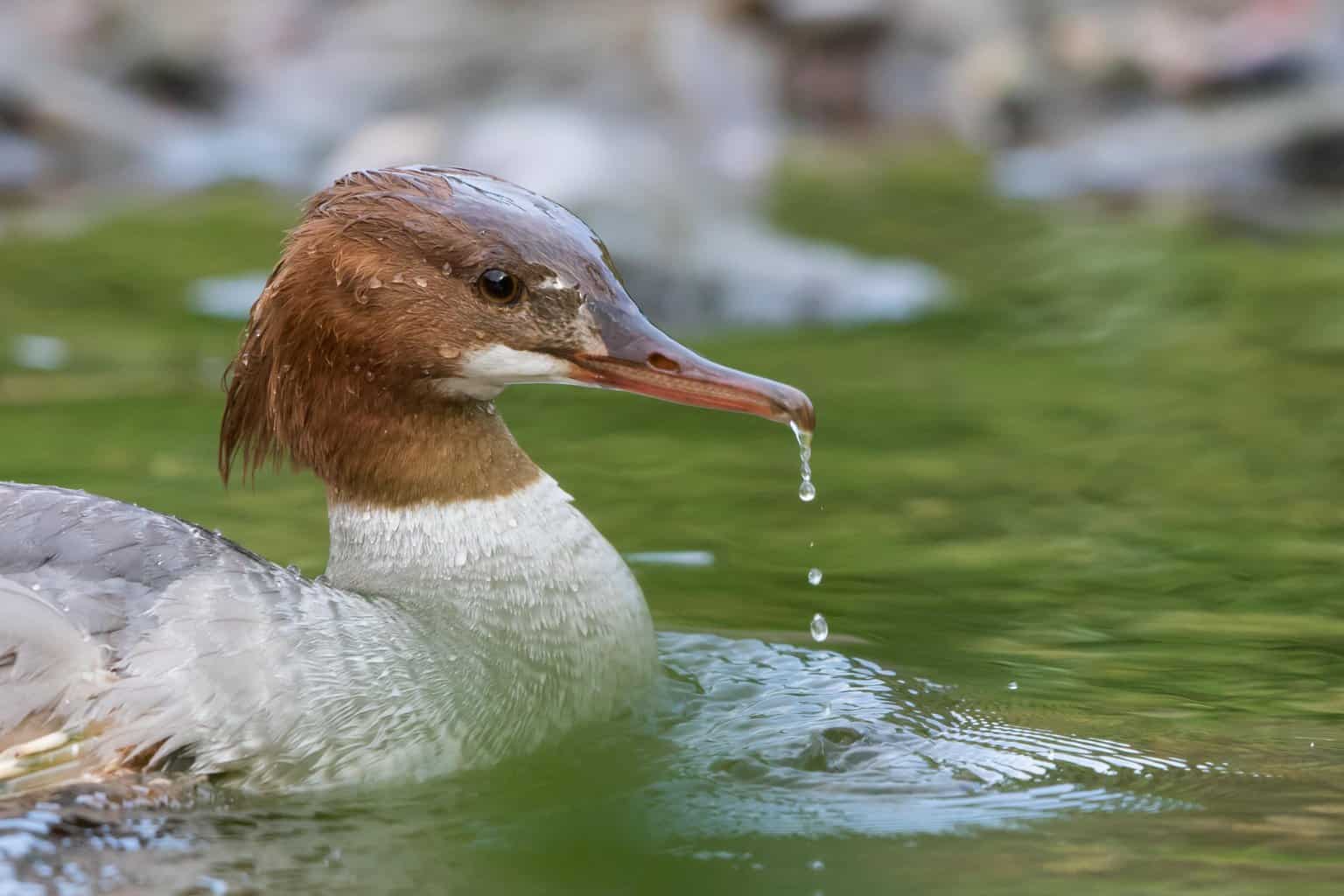
- Mergus merganser
- Length: 22 – 27 in (56 – 69 cm)
- Weight: 60.8 oz (1723 g)
- Wingspan: 31 – 37 in (79 – 94 cm)
Maine’s Common Mergansers are either summer or year-round residents. Their territory covers about 40 miles of coastline between York and Hancock Counties.
Common Mergansers are vibrant and flashy ducks. Males have an iridescent green head and a bright red bill. His belly is white, and his eyes and back are black.
Females, on the other hand, have a reddish-brown head with a shaggy crest and a gray back. They are white-breasted and gray-bellied.
The serrated bill of a Common Merganser has evolved to let them easily tear up their prey, including fish, mollusks, frogs, worms, insects, and even some small mammals.
Common Mergansers frequently live with Buffleheads and have very similar territorial preferences.
Eurasian Wigeon (Dabbling Duck)
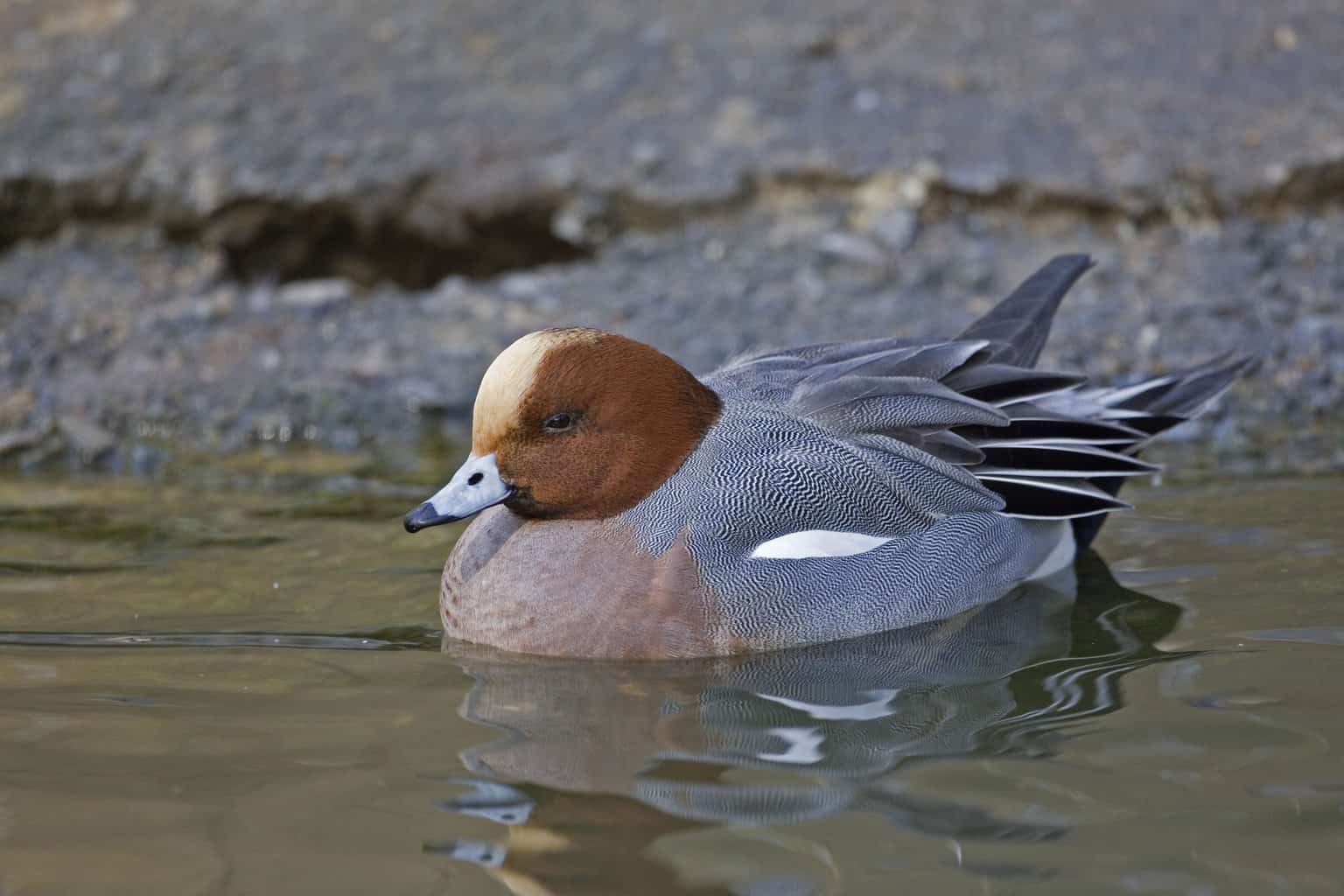
- Mareca penelope
- Length: 17-20 inches
- Weight: 1.102-2.366 pounds
- Wingspan: 28-31 inches
Although Eurasian Wigeons are pretty rare in North America, they do sometimes make their way to North America for the winter. Their breeding territory includes Russian, Europe, and China. Small numbers of Eurasian Wigeons winter in a few spots in the US.
They have been seen in Maine, even though their typical winter territory is just a bit further down the coast.
They breed across Russia, Europe, and China, and some make their way to North America for the winter.
Males are gray-bodied with a rufous head. The male also has a beige forehead and a very light brown chest. His bill is gray with a black tip.
Females are mostly dark brown, but they also have a light belly and some dark brown markings on their backs. The female has a bill that is all black.
The Eurasian Wigeon winters in a few areas along the Atlantic Coast. They are almost always sighted in groups of American Wigeons, and rarely with any other species. They winter on large lakes, usually along the coast.
Fulvous Whistling Duck (Tree Duck/Dabbling Duck)
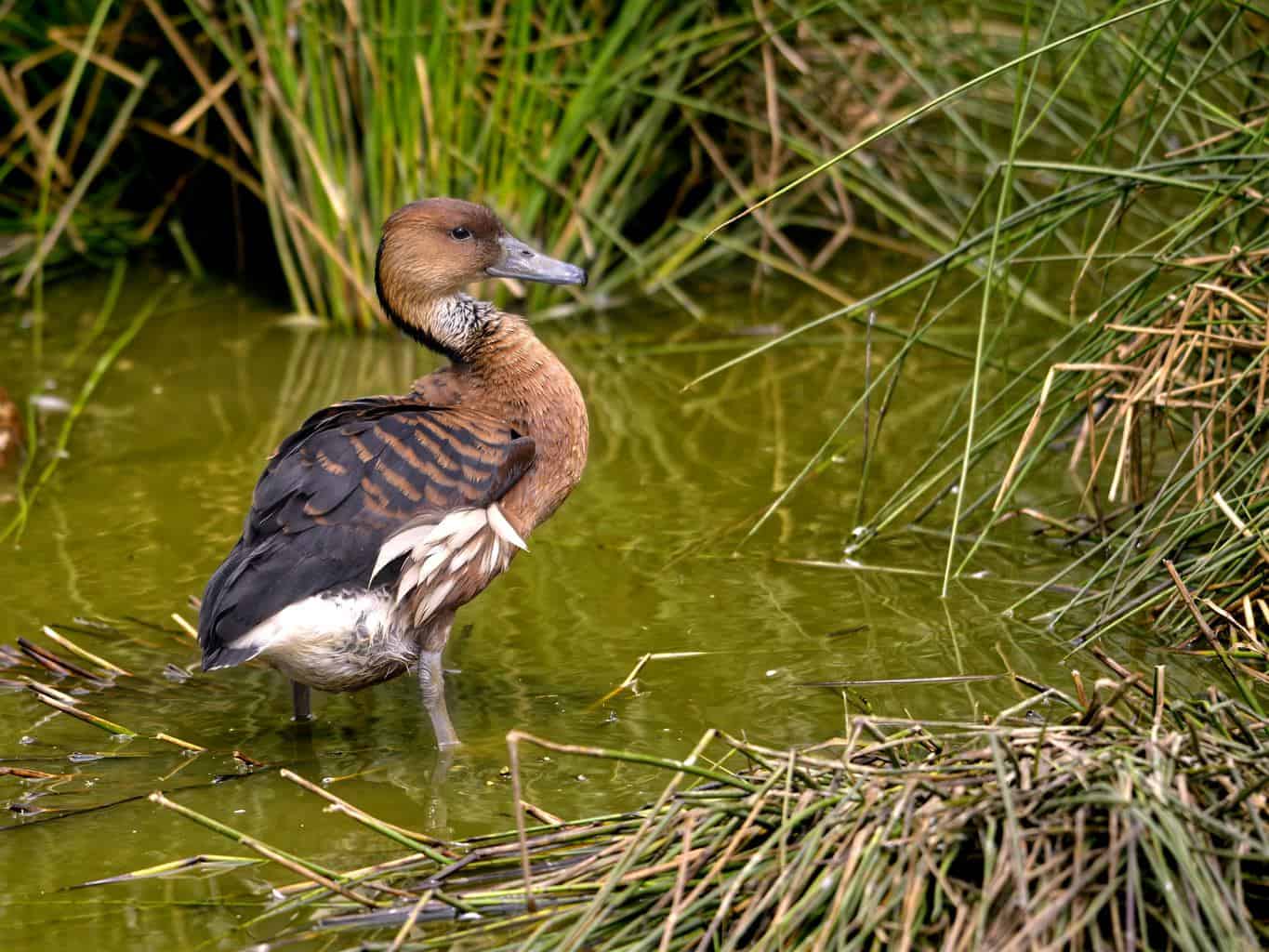
- Dendrocygna bicolor
- Lenth: 18 – 21 in (45 – 53 cm)
- Weight: 25 – 37 oz (1.5 – 2.3 lb)
- Wingspan: 33 – 40 in (83 – 101 cm)
Fulvous Whistling Ducks are vagrants in coastal Maine. They have not been documented in the state since 1972!
Seeing a Fulvous Whistling Duck in Maine is incredibly unlikely, but as they have been spotted here, it is important to know that you could have the rare opportunity to see one here.
Whistling ducks, which used to be called tree ducks, are sexually monomorphic instead of dimorphic. This means there is no outward difference between the sexes. All Fulvous Whistling Ducks, then, are caramel-brown with black stripes on their backs. They have long necks and legs.
As filter feeders, they scoop up a mouthful of water and then let it strain out of their bills, leaving them with a mouthful of invertebrates and seeds.
Fulvous Whistling Ducks are widespread around the globe. In addition to being residents of North America, they also live in Africa, South America, and Asia.
Gadwall (Dabbling Duck)
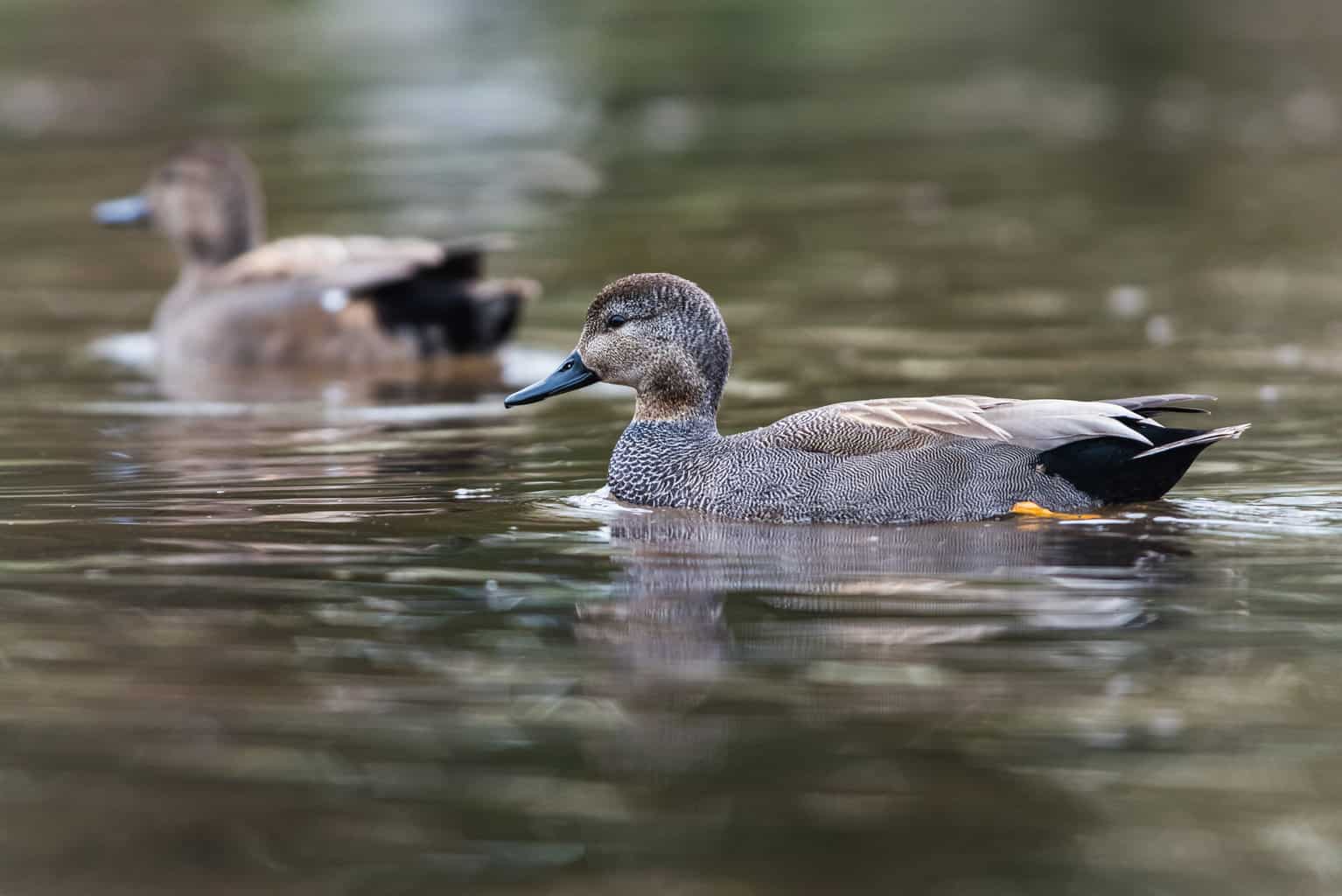
- Mareca strepera
- Length: 19 – 23 in (48 – 58 cm)
- Weight: 35.27 oz (1000 g)
- Wingspan: 31 – 36 in (79 – 91 cm)
Birders are most likely to find Gadwall in Maine during their migration windows in the spring and fall. They are found in many different kinds of water, including freshwater and seawater.
They inhabit reservoirs, marshes, estuaries, and even sewage ponds and city parks. They have been documented in Sabattus Pond in Sabbatus.
Gadwall males are delicately patterned in small, black, and gray scallops. Their tail feathers are black, and their gray-brown head is dappled. The Gadwall’s head is very round, and males have a black bill.
Female Gadwall have a much larger pattern than male Gadwall. They have an orange bill and an overall light-and-dark brown appearance.
Both males and females have white wing markings.
Even though Gadwall are plentiful in other states because they have such high rates of breeding success, you will still have to look hard for them in Maine. The state is just barely outside of a small breeding area on the coast of New Brunswick.
Garganey Duck (Dabbling Duck)

- Spatula querquedula
- Length: 16 in (41 cm)
- Weight: 10.5 – 15.5 oz (300 – 400 g)
- Wingspan: 22.8 – 27.1 in (58 – 69 cm)
Garganey Ducks have only been spotted in Maine two times: once in 1994, and once in 1999. They are very rare accidental migrants to North America who typically don’t leave their breeding and wintering territories across Europe, Russia, Africa, and South Asia.
The male Garganey is a small brown duck. During the breeding season, he has a white stripe on his face that looks like an eyebrow. He has gray wings and a black bill.
Females are light-colored with small, off-white “eyebrows” and a dark stripe across their eyes. During the winter, it is difficult to differentiate between females and males, as the males lose their distinctive facial markings.
Greater Scaup (Diving Duck)
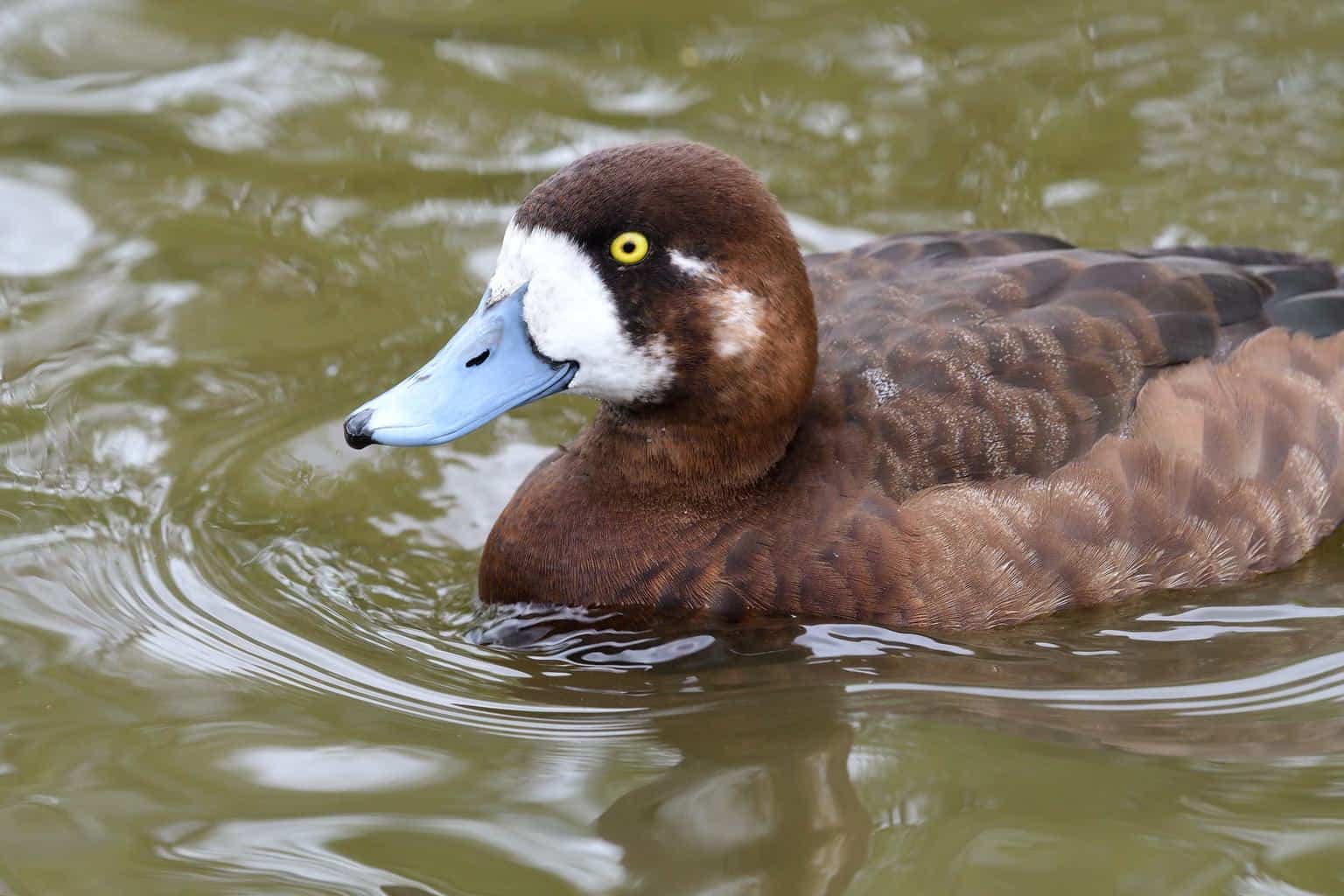
- Aythya marila
- Length: 15-22 inches
- Weight: 1.5-2.9 pounds
- Wingspan: 28-33 inches
Greater Scaup are a threatened species in Maine. Although they were previously commonplace as both migratory and wintering ducks in the state, their numbers have been steeply declining in recent years.
Greater Scaup males are mostly white, but they have black and brown bars across their backs. They have an iridescent green head during the breeding season. During the winter, they lose their vibrant colors and look a lot like the females.
The female is light brown with a dark brown head. She has very few markings, except for a thick pale ring that circles the base of her bill.
Green-Winged Teal Duck (Dabbling Duck)
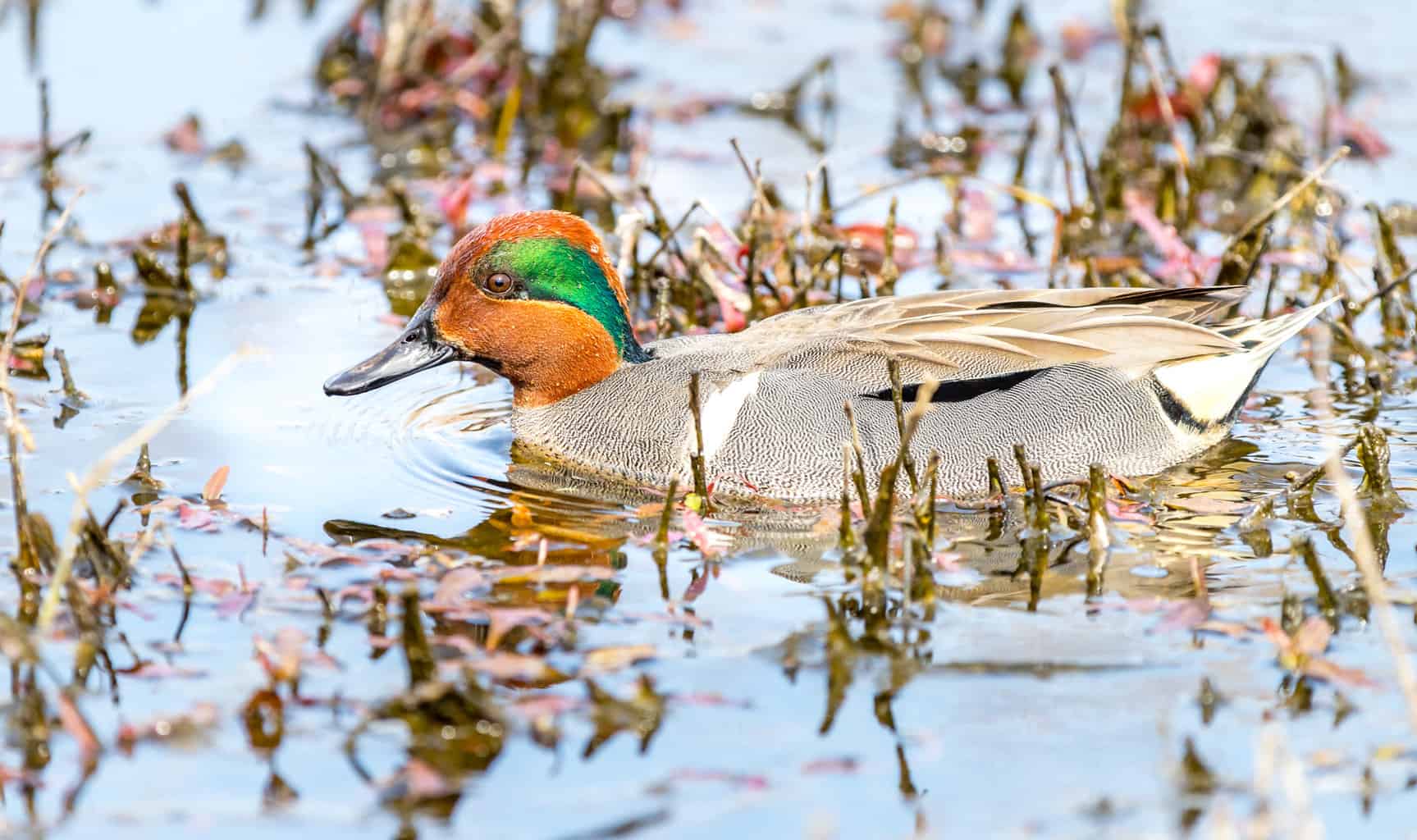
- Anas crecca
- Length: 12.2 – 15.3 in (31 – 39 cm)
- Weight: 4.9 – 17.6 oz (140 – 500 g)
- Wingspan: 20.5 – 23.2 in (52 – 59 cm)
Green-Winged Teal Ducks are commonplace in Maine during the summer. They are widespread across the entire state, preferring to live near freshwater lakes and marshes. As dabbling ducks, they prefer shallow waters.
Green-Winged Teal Duck males are gray with chocolate-brown heads. The male has a streak of iridescent green over his eyes that extends down to the back of his head. He also has a green speculum.
It can be a challenge to differentiate between immature males and females. They both have dark and light brown feathers, but she has a yellow streak that runs the length of her tail feathers.
Many ducks need to get a running start to take off into flight, but Green-Winged Teal Ducks are among the ducks that can take off directly from the water.
Harlequin Duck (Sea Duck)
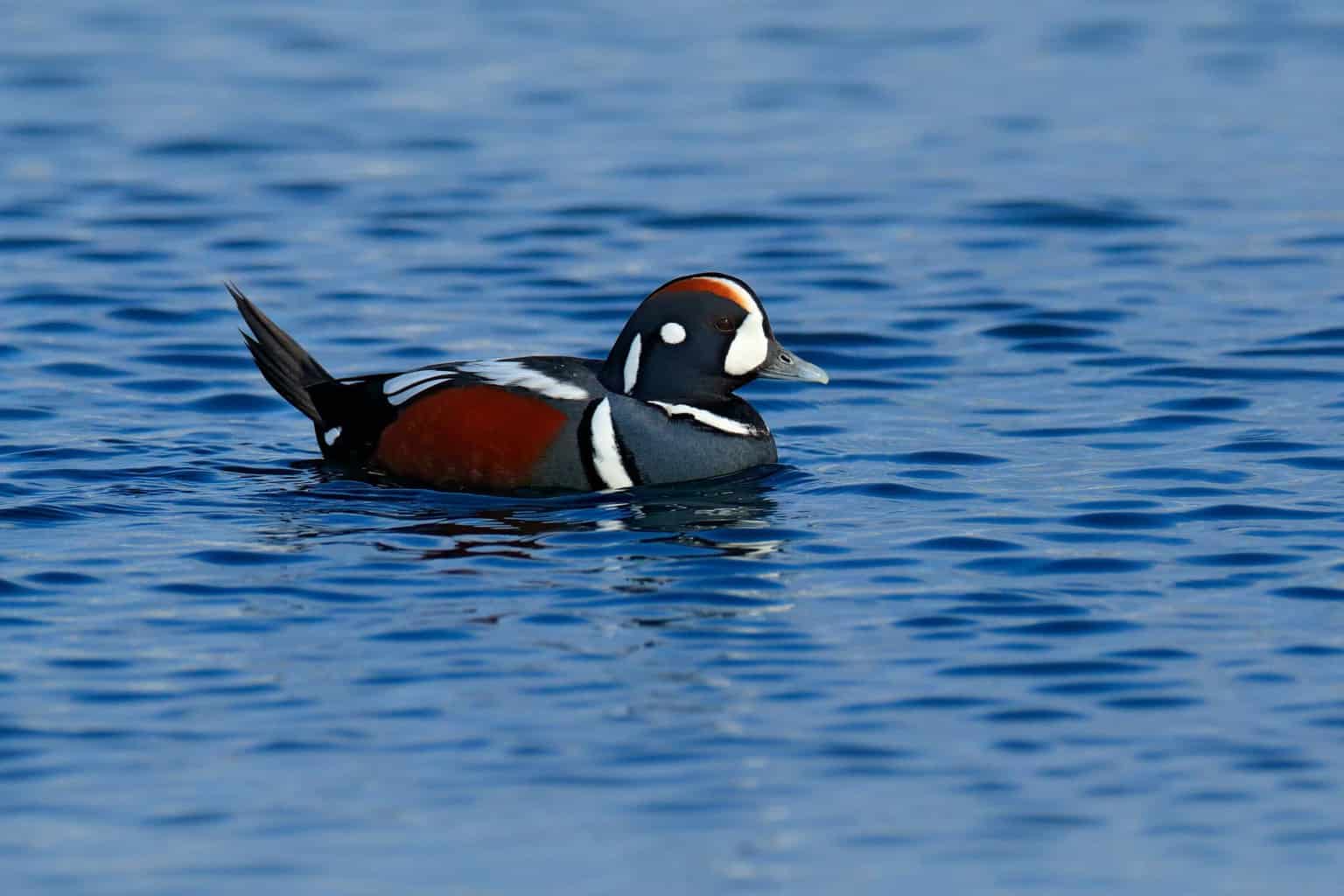
- Histrionicus histrionicus
- Length: 15 – 21 in (38 – 53 cm)
- Weight: 24 oz (680 g)
- Wingspan: 26 – 28 in (66 – 71 cm)
Harlequin Ducks are only found during the winter in Maine. They do not stray from the Atlantic Coast, so you will not see them inland. Unfortunately, they are a threatened species in the state, which has led to conservation strategies to protect them.
Male Harlequin Ducks are beautiful little sea ducks. They are mostly slate blue, and they have black-outlined white stripes on the neck, head, and chest. He has a chestnut brown stripe on the top of his head, and chestnut coloring on his sides and under his wings.
Females are dark brown with a small white patch at the base of the neck.
Harlequin Ducks have a cute nickname: the Sea Mouse! It’s not because they are small, even though they are small. It’s because their vocalizations are mouse-like.
Hooded Merganser (Diving Duck)
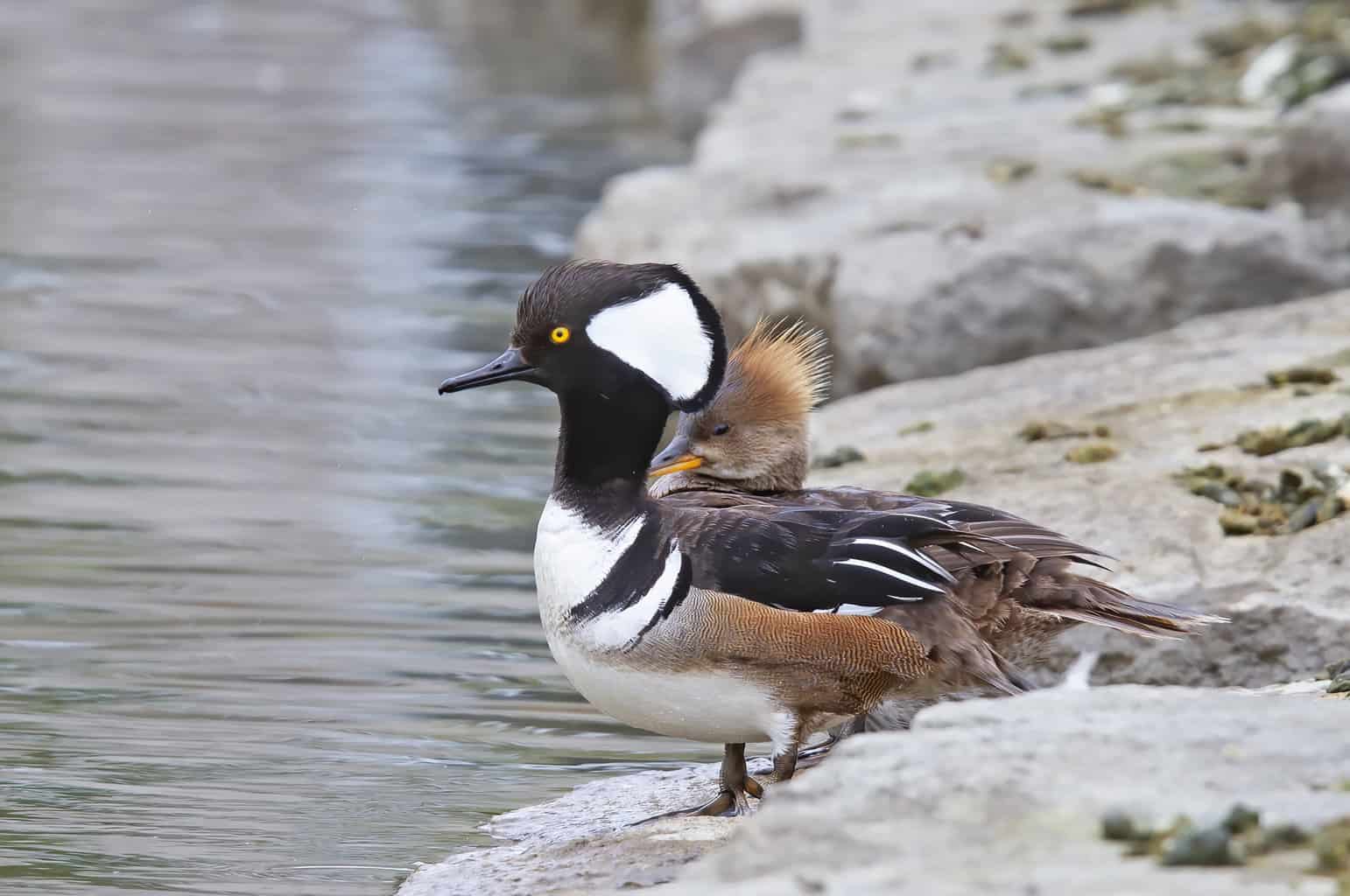
- Lophodytes cucullatus
- Length: 16 – 19 in (41 – 48 cm)
- Weight: 32.09 oz (909 g)
- Wingspan: 24 – 26 in (61 – 66 cm)
Hooded Mergansers are year-round residents of New England, including most of Maine. In the northern part of the state, they are only present for the breeding season.
The Hooded Merganser male has a fluffy head with a black and white crest. He raises and lowers the crest when he wants to. Most of his body is black and white, but he has brown sides. His bill is all black.
The female has a much shaggier crest, and her head is cinnamon brown instead of black and white. She does not have any other noteworthy markings. Some females have orange on their otherwise dark bills.
Many ducks have nicknames, and you can count the Hooded Merganser among them. This little duck is known as the “frog duck,” thanks to their frog-like croaking sound.
King Eider (Sea Duck)
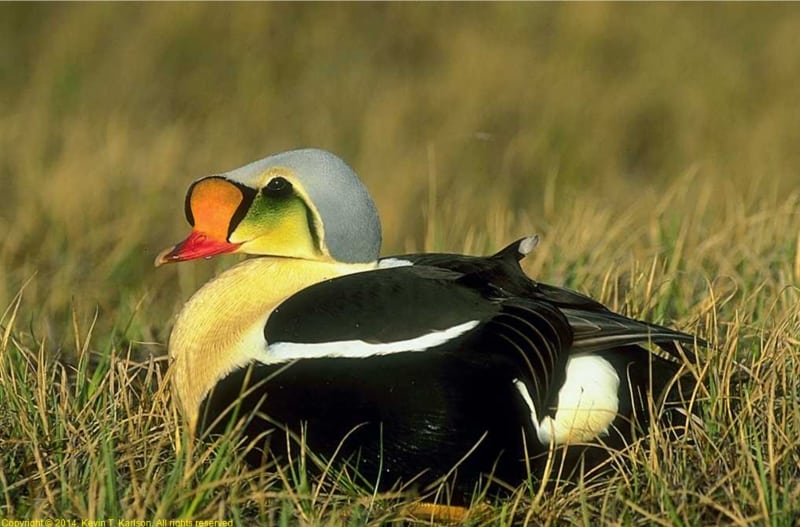
- Somateria spectabilis
- Length: 20 – 28 in (50 – 70 cm)
- Weight: 2.6 – 4.6 lb (1.2–2.1 kg)
- Wingspan: 34 – 40 in (86 – 102 cm)
King Eiders live in Maine’s coastal waters during the winter. They are often seen among large groups of other ducks, so you have to carefully scan the waters for the male’s flashy colors.
Male King Eiders have a uniquely shaped head. It is oblong with a large orange plate above the bill, creating a bulging forehead. He has a black and white body and a light blue crown. His bill is mostly bright red.
Female King Eiders are more subdued, dark brown with pale brown areas, including the cheek and neck. The female’s bill is black.
Males and females alike are large, with thick, strong necks.
They are exclusively found in seawater. Your best chance is to see them near a pier or jetty.
Lesser Scaup (Diving Duck)
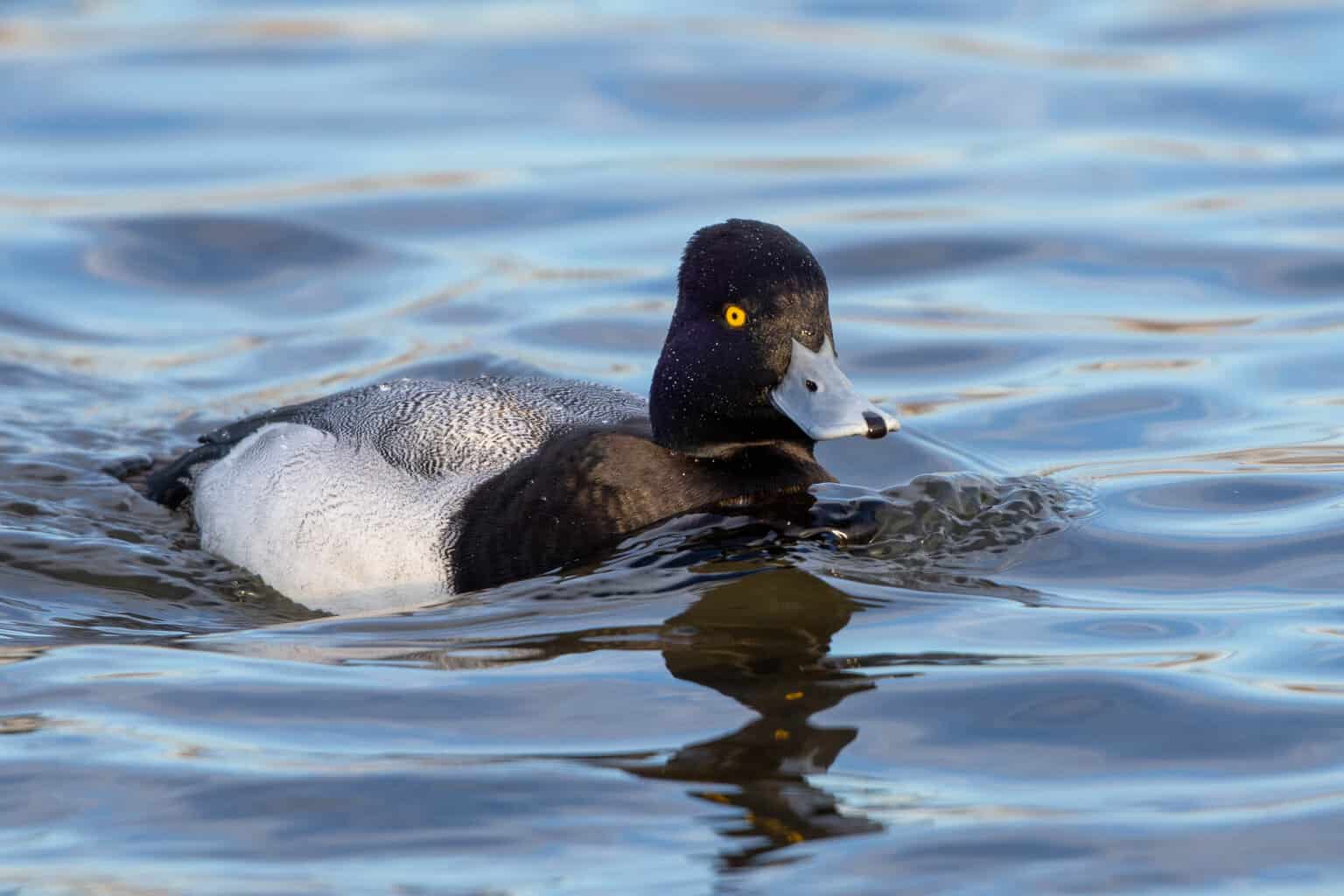
- Aythya affinis
- Length: 15 – 18 in (38 – 49 cm)
- Weight: 40.77 oz (1155 g)
- Wingspan: 24 – 33 in (61 – 84 cm)
Lesser Scaup are uncommon migrants in Maine. They start their migration to their breeding territory as early as mid-February, but they continue to travel through the end of May. Their fall migration occurs around October.
The Lesser Scaup looks pretty similar to its close relative, the Greater Scaup. The male’s head is iridescent and shimmers in dark green and purple. He has a barred gray and black body.
The female is dark brown with a white face patch near her bill.
To quickly differentiate between these two ducks, check for a few “stray hairs” on top of the head. Lesser Scaup have just the tiniest crest that Greater Scaup lack.
Lesser Scaup are excellent at camouflage, but they also play dead when threatened by a predator.
Long-Tailed Duck (Sea Duck)
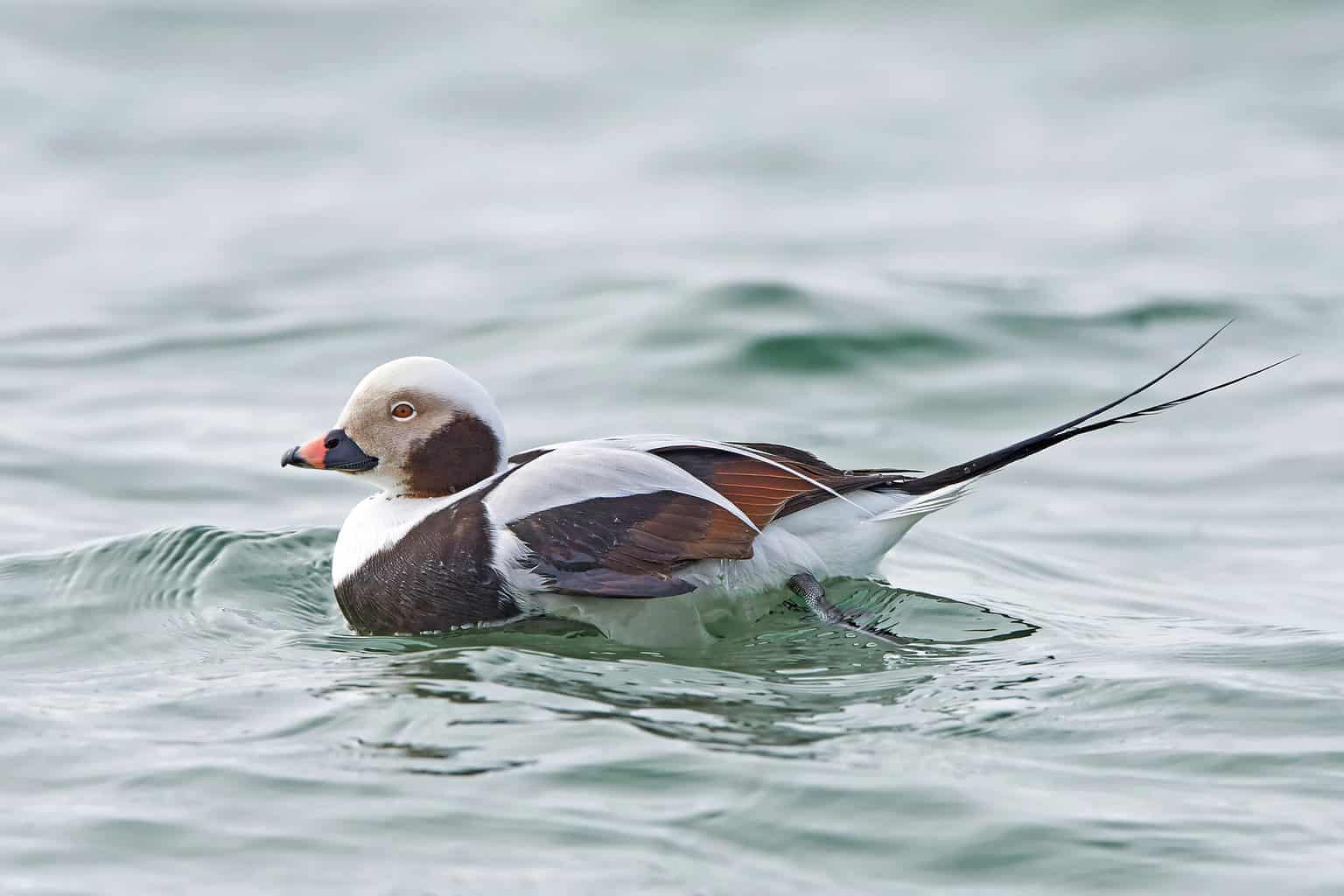
- Clangula hyemalis
- Length: 15 – 22 in (38 – 56 cm)
- Weight: 31.74 oz (900 g)
- Wingspan: 26 – 31 in (66 – 79 cm)
Long-Tailed Ducks breed in the Arctic North and migrate short distances for the winter. They barely travel south of New England or the Pacific Northwest. In Maine, they are often far from the coast in deep, ocean waters, as they can dive up to 200 feet below the surface for their food.
Perhaps the most unusual trait of the Long-Tailed Duck is the way that it changes in appearance between breeding and non-breeding seasons.
Plenty of ducks, especially males, lose their vibrant colors after the breeding season, but Long-Tailed Ducks do something totally different. They reverse their colors.
Males and females alike will change the white areas on their bodies for dark feathers, and their dark feathers for white ones. Males are black and white, with some gray. Females are brown and white.
Mallard Duck (Dabbling Duck)
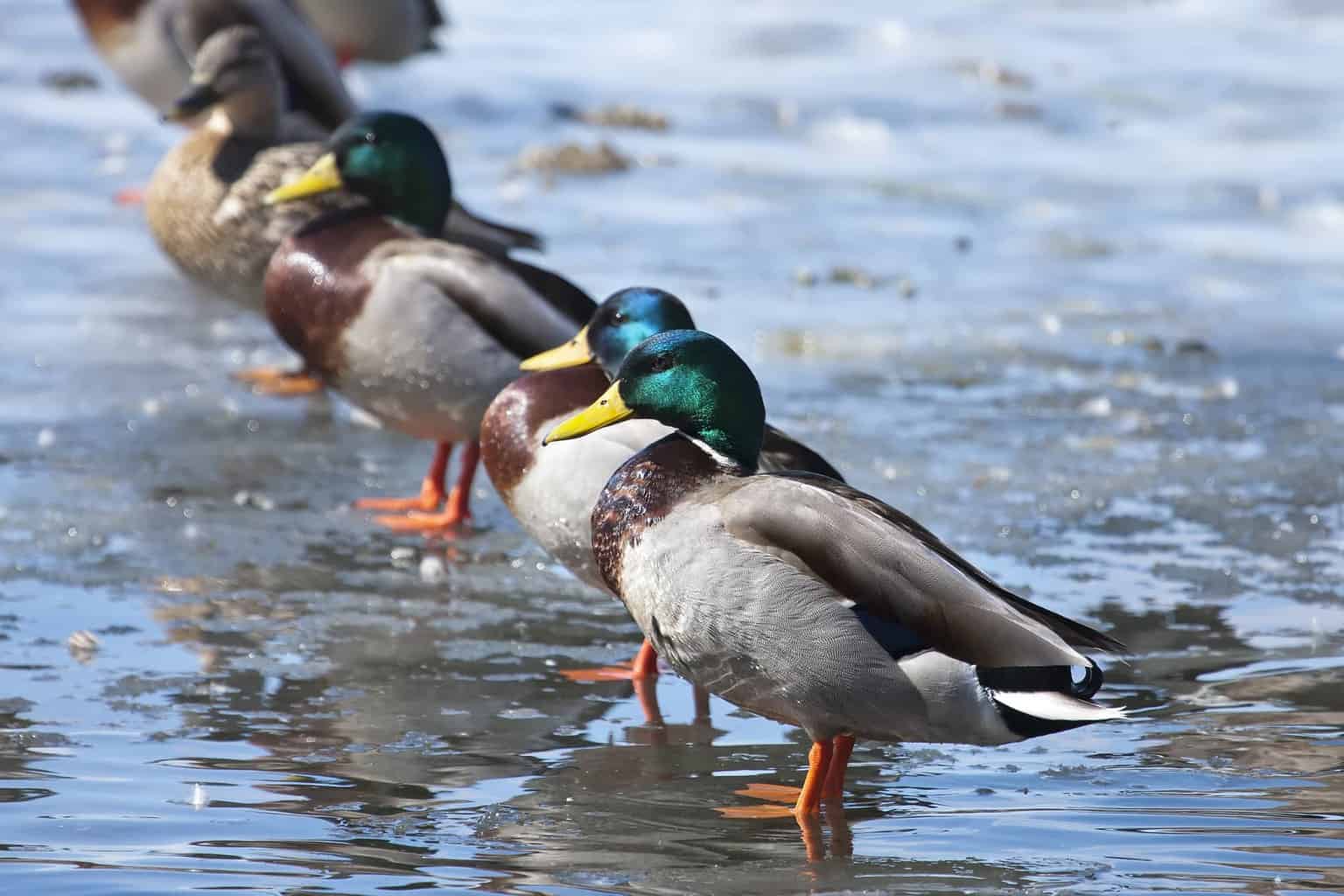
- Anas platyrhynchos
- Length: 19.7 – 25.6 in (50 – 65 cm)
- Weight: 35.3 – 45.9 oz (1000 – 1300 g)
- Wingspan: 32.3 – 37.4 in (82 – 95 cm)
Mallards are prevalent across much of the world, including most of North America. They are plentiful in Maine, especially along the Atlantic Coast. They inhabit the state year-round, usually in wetlands.
As nighttime foragers, Mallards are important to the ecosystems where they live, as they spread seeds everywhere they go. Their diet consists of seeds, roots, stems, and other parts of the plants.
The male Mallard may be the most iconic duck in the world, with his iridescent green head, white ring around his neck, gray body, blue speculum, brown breast, and yellow bill.
Females are patterned in multiple shades of brown. Her head is light brown, and her bill is mostly orange but topped and tipped in black.
One of the reasons Mallards are so easy to identify, even for new birders, is the fact that most of us grow up with images of these ducks all around us. They are frequently represented in home decor, paintings, figurines, and even kids’ toys.
- Love, play, cuddle and squeeze! Squishmallows are the softest, cutest plush toys around!
- Meet Avery the Mallard Duck! Featuring soft plush fabric, Squishmallows have their own style and personality encouraging fun and...
- The snuggle is real! The large squishy plush makes for the perfect cuddle companion! These super soft, collectible plush toys are...
Last update on 2024-04-27 / Affiliate links / Images from Amazon Product Advertising API
Northern Pintail (Dabbling Duck)
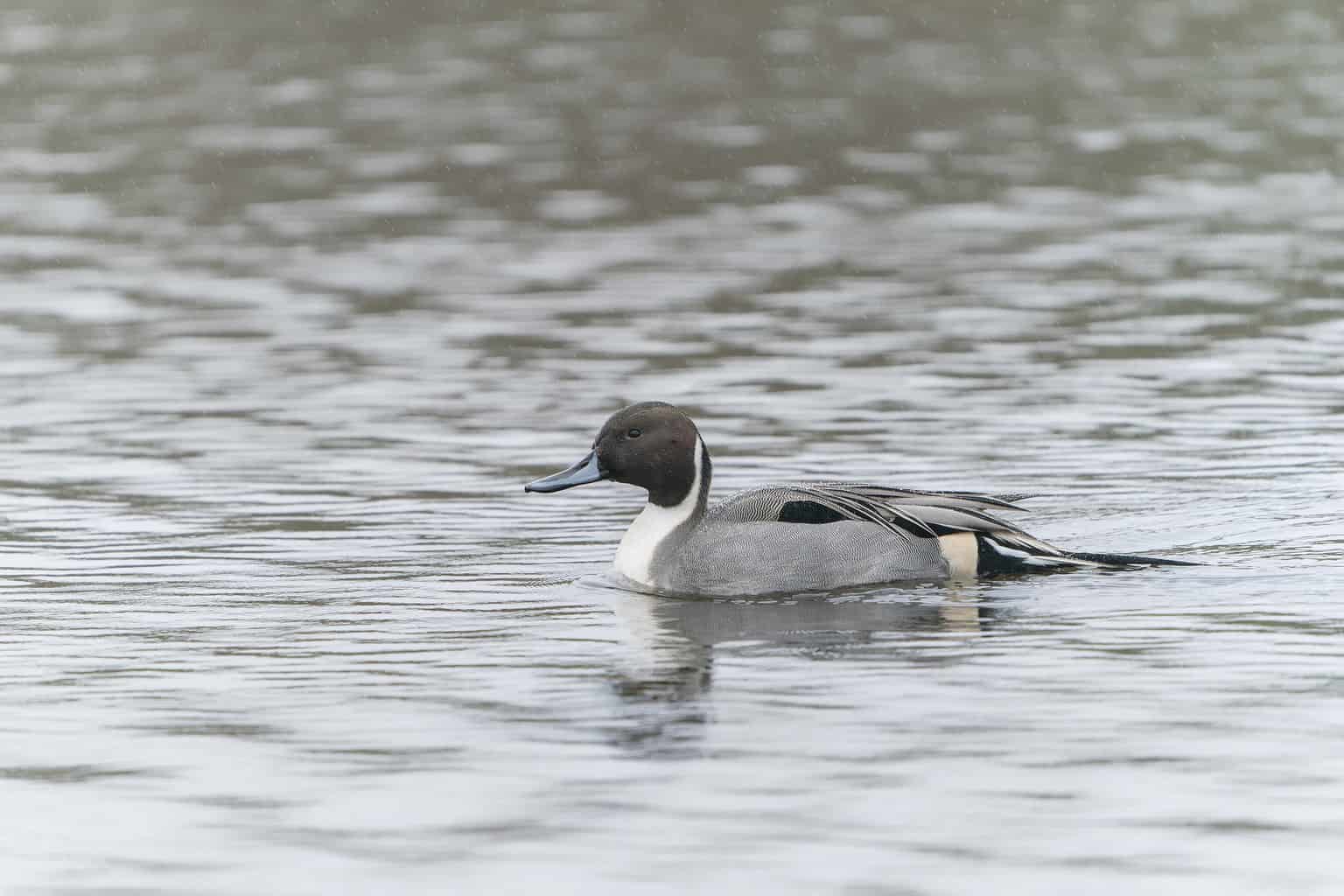
- Anas acuta
- Length: 20 – 26 in (51 – 66 cm)
- Weight: 36.33 oz (1030 g)
- Wingspan: 29 – 35 in (74 – 89 cm)
Maine is part of the Northern Pintail’s migration routes, in between their northern breeding grounds and southern wintering territory. Their diet is mostly made up of seeds and grasses, but they are also willing to eat insects and crustaceans.
Breeding season males get their name from their long, pointed tail feathers. In their fall molting, these tail feathers fall off, but they still have a pointed silhouette.
Males are gray, brown, white, and black. The male’s head is dark brown, and there is a white stripe running down his neck.
Females have a pointed tail as well, but it is much shorter than her male counterpart. The female has an intricately patterned brown body.
Northern Shoveler (Dabbling Duck)

- Spatula clypeata
- Length: 17.3 – 20.1 in (44 – 51 cm)
- Weight: 14.1 – 28.9 oz (400 – 820 g)
- Wingspan: 27.2 – 33.1 in (69 – 84 cm)
Northern Shovelers migrate through Maine in the spring and fall. There are some who breed right along the northern edge of the state, but for the most part, you will only see these birds as they move between their winter and summer habitats.
Both male and female Northern Shovelers have a large, spatula-shaped bill that is lined inside with comb-like bristles. They use these bristles to scoop up food and water and then filter out the water.
Males have an iridescent green head and white breast. His back is black, and he has brown sides and yellow eyes. He has a dark gray bill.
Females are mottled in brown and have some light blue coloring on their wings. The female’s bill is yellowish-gray and has orange edges.
Northern Shovelers have an interesting way of stirring up food. They gather together in groups and start to spin at the same time, creating a pinwheel effect. The motion of the water dredges up food from the bottom of the water.
You may see Northern Shovelers by themselves as opposed to gathering with lots of other ducks because they prefer to inhabit stagnant, muddy wetlands that other ducks are more likely to avoid.
Red-Breasted Merganser (Sea Duck)
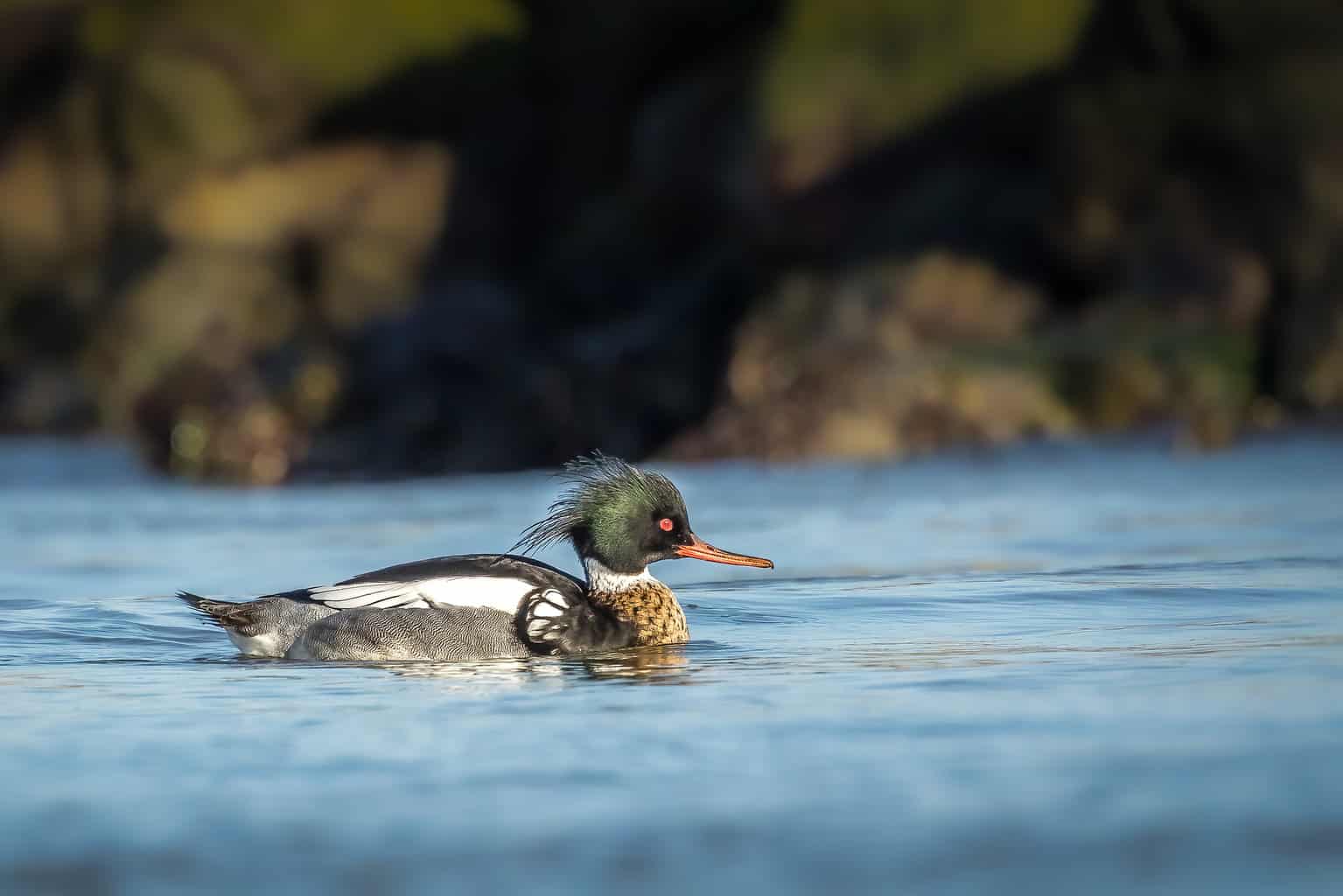
- Mergus serrator
- Length: 16 – 26 in (41 – 66 cm)
- Weight: 47.61 oz (1349 g)
- Wingspan: 31 – 35 in (79 – 89 cm)
Red-Breasted Mergansers breed along Maine’s inland lakes. They winter through much of the rest of New England, including ice-free inland waters.
They are noteworthy for their speed: Red-Breasted Mergansers have been documented at up to 81 miles per hour!
The male Red-Breasted Merganser is known for his spiky, shaggy crest on the back of his dark green head. He has a thin, serrated bill that he uses to rip apart his prey. He also has a white ring around his neck. His chest is brown and he has gray sides.
Females also have a crest, but it is reddish-brown to match the rest of her head. She is white-throated, and her bill looks like the male’s bill.
Red-Breasted Mergansers eat fish, insects, crustaceans, tadpoles, and other aquatic invertebrates.
Redhead Duck (Diving Duck)
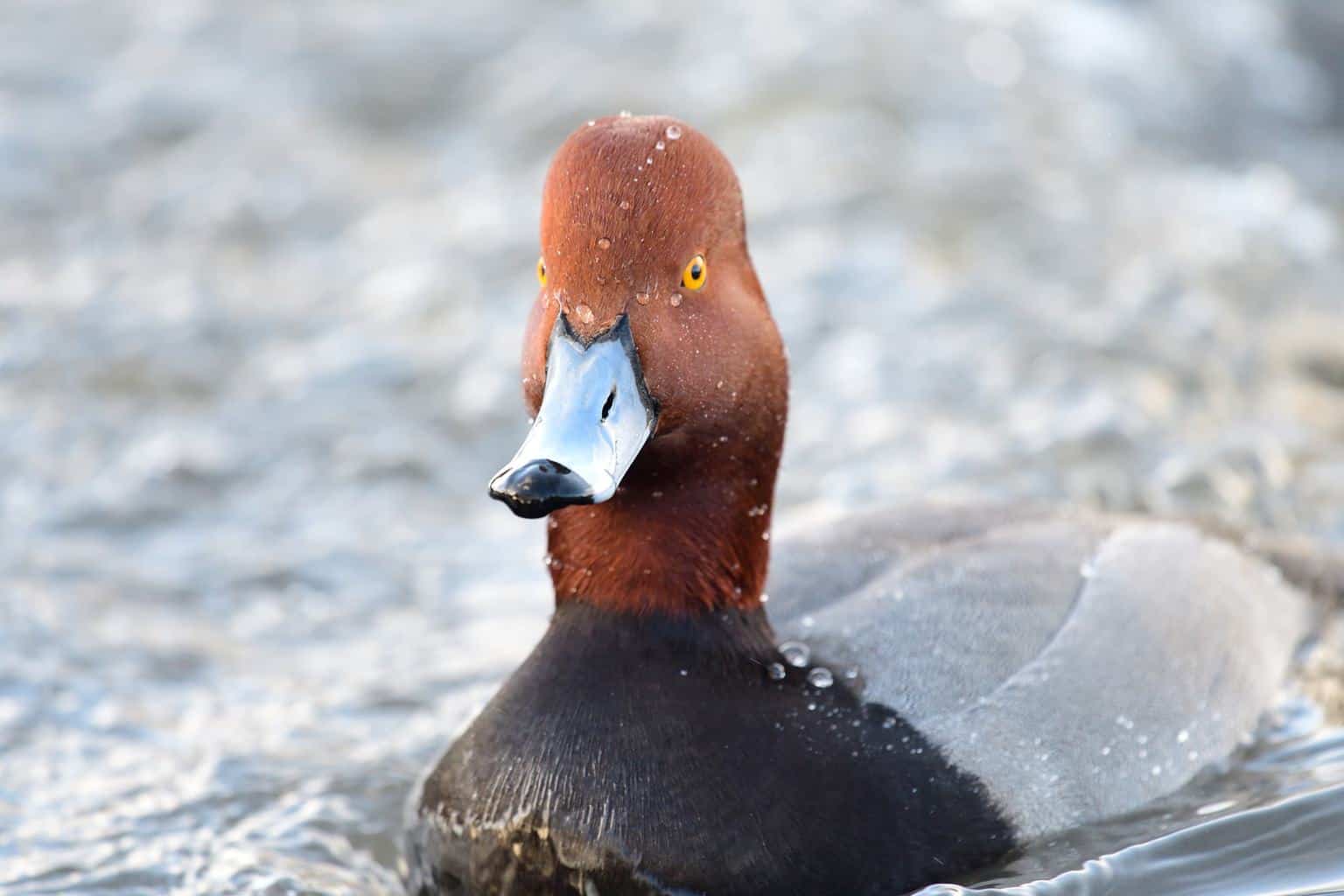
- Aythya americana
- Length: 18 -22 in (46 – 56 cm)
- Weight: 43.03 oz (1219 g)
- Wingspan: 29 – 35 in (74 – 89 cm)
Redhead Ducks are not very common in Maine, but they do sometimes make an appearance. A small strip of breeding territory borders Maine’s northernmost regions.
The male Redhead gives this duck its name. His head is coppery-brown and almost red in appearance. He has blueish-gray feet and a pale blue bill that is tipped in black. His bill is also banded in white. His orange eyes stand out, and he has a black chest and tail, a gray back, and a white breast.
Female and male Redheads don’t look too different from one another in terms of their patterning, but the female is much lighter in color.
Females practice brood parasitism, in which they lay their eggs in the nests of other Redhead ducks. They do this to increase their reproductive success. They also raise most of their own ducklings.
Ring-Necked Duck (Diving Duck)
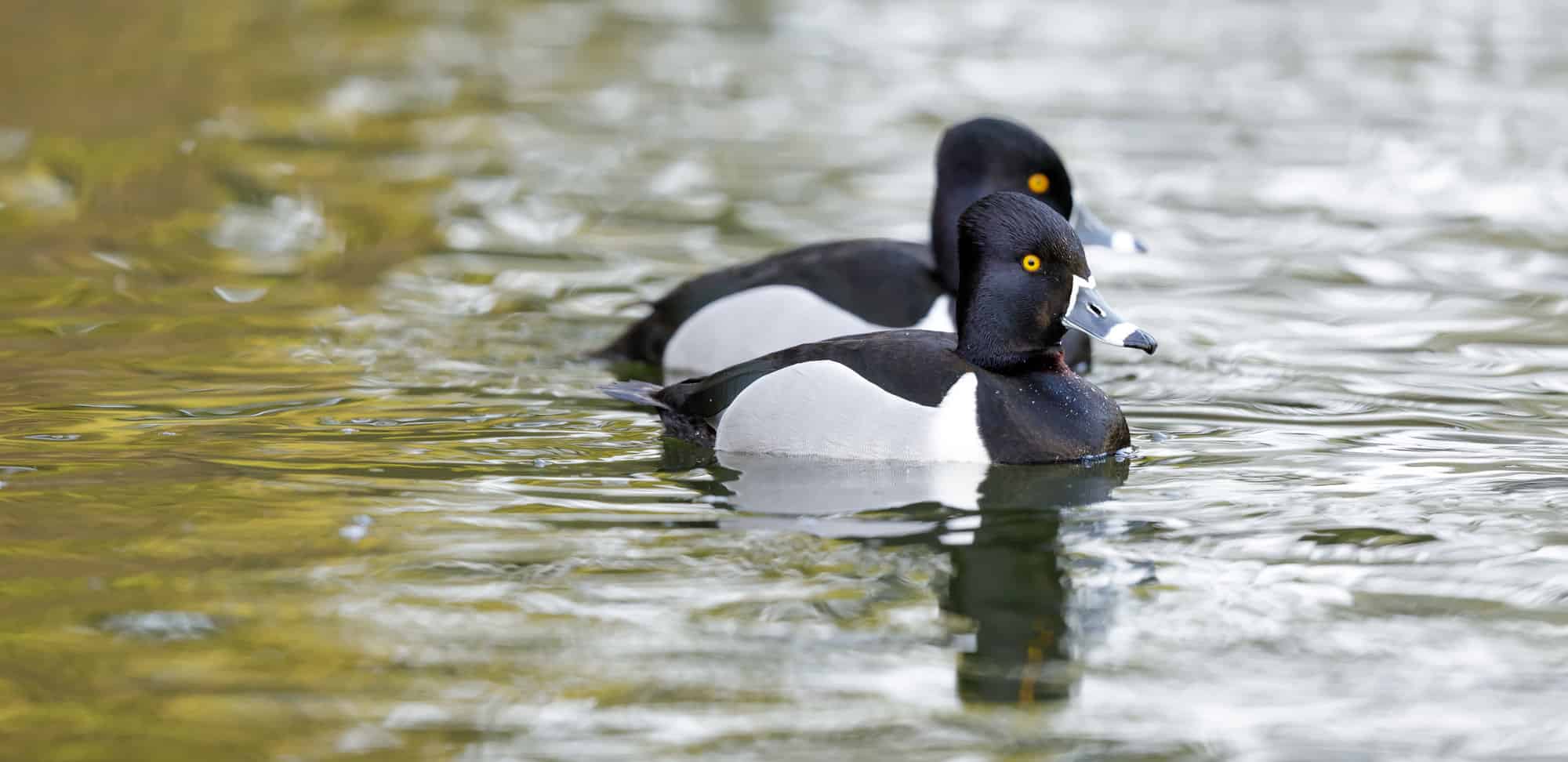
- Aythya collaris
- Length: 14 – 18 in (36 – 46 cm)
- Weight: 32.09 oz (909 g)
- Wingspan: 24 – 30 in (61 – 76 cm)
Ring-Necked Ducks used to be very rare in Maine, but they started increasing their population in the 1940s. Today, they have a stable population as breeding residents in the state.
They prefer shallow waters, despite being diving ducks. They are often found near Maine’s Greater Scaup and Lesser Scaup.
Ring-Necked Ducks are an excellent example of a bird whose name does not match its appearance. They technically have a ring around their neck, but it is dark copper and barely stands out from their dark head and neck feathers.
Some have even argued to rename the Ring-Necked Duck to something that made more sense, like the Ringbill Duck, as they do have a noticeable white ring near the tip of his bill and another around the base of his bill.
Otherwise, he is mostly black with gray sides.
Females have a white band near the tip of their bill, and they are mostly brown.
Ruddy Duck (Diving Duck)
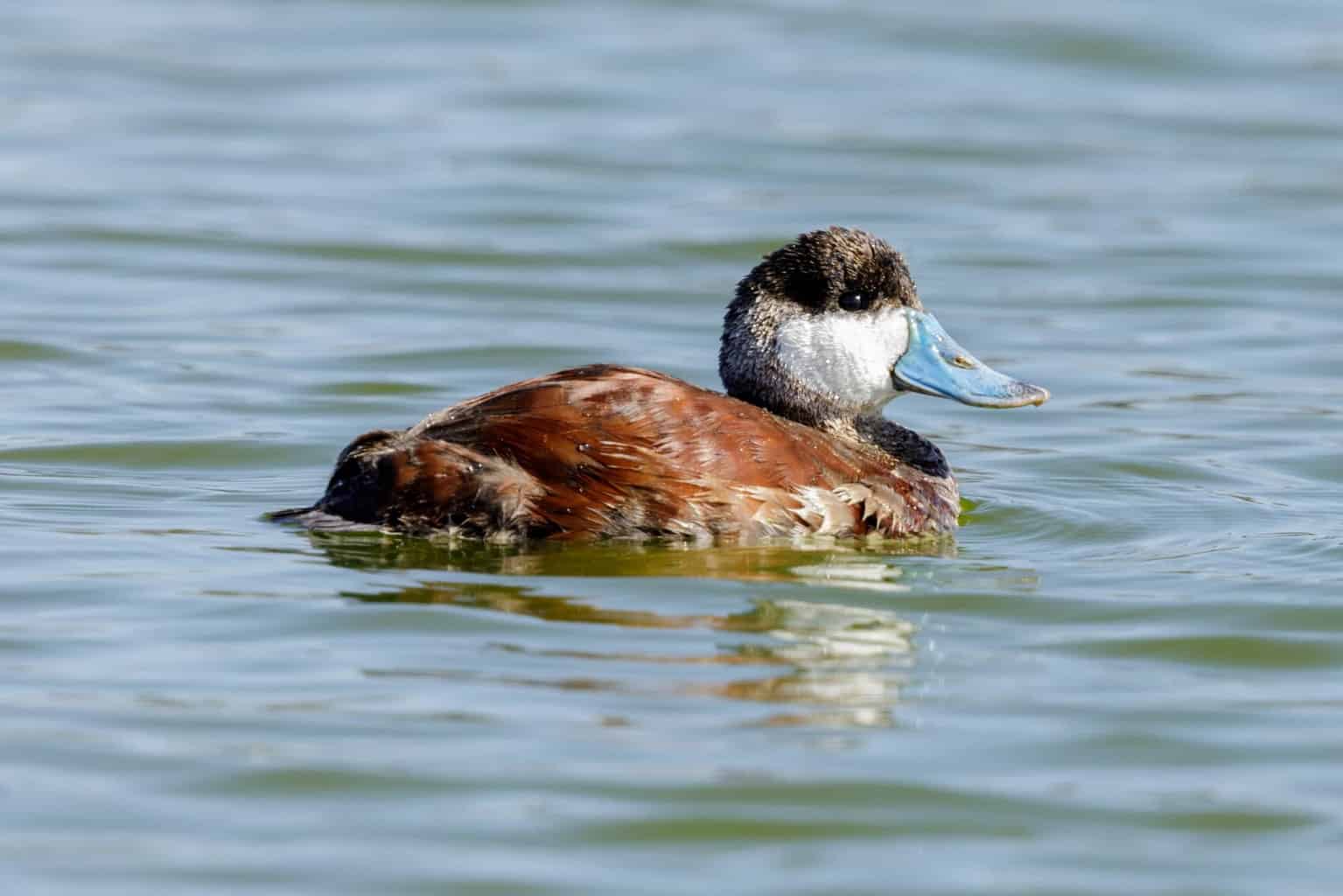
- Oxyura jamaicensis
- Length: 14 – 16 in (35.56 – 40.64 cm)
- Weight: 28.04 oz (795 g)
- Wingspan: 21 – 24 in (53 – 61 cm)
Most of Maine will only see Ruddy Ducks when they are mid-migration in the spring and fall, but their winter territory is just a little bit south. That means some may make their way into the state for the winter. They have been seen mid-winter on Sabbatus Pond.
Ruddy Duck males in the breeding season are dark brown with a mostly black head. They also have a large white cheek patch and a thick, light blue bill. Their winter coloring is dull gray.
Female Ruddy Ducks are light and dark brown with a dappled pattern. They have gray cheek patches instead of white, and their bills are black.
Sometimes Ruddy Ducks are called the “bull-necked teal” because of their thick, bulky appearance.
Ruddy Ducks are quite tame, and they don’t immediately disperse at the sight of people. Even so, they are great at hiding their nests in the aquatic grasses that grow along the edges of their breeding habitat of freshwater marshes and ponds. Their nests will be found only a few inches away from the water!
Unfortunately, you will not see Ruddy Duck nests in Maine because they are not present in the state during their breeding season.
Surf Scoter (Diving Duck)
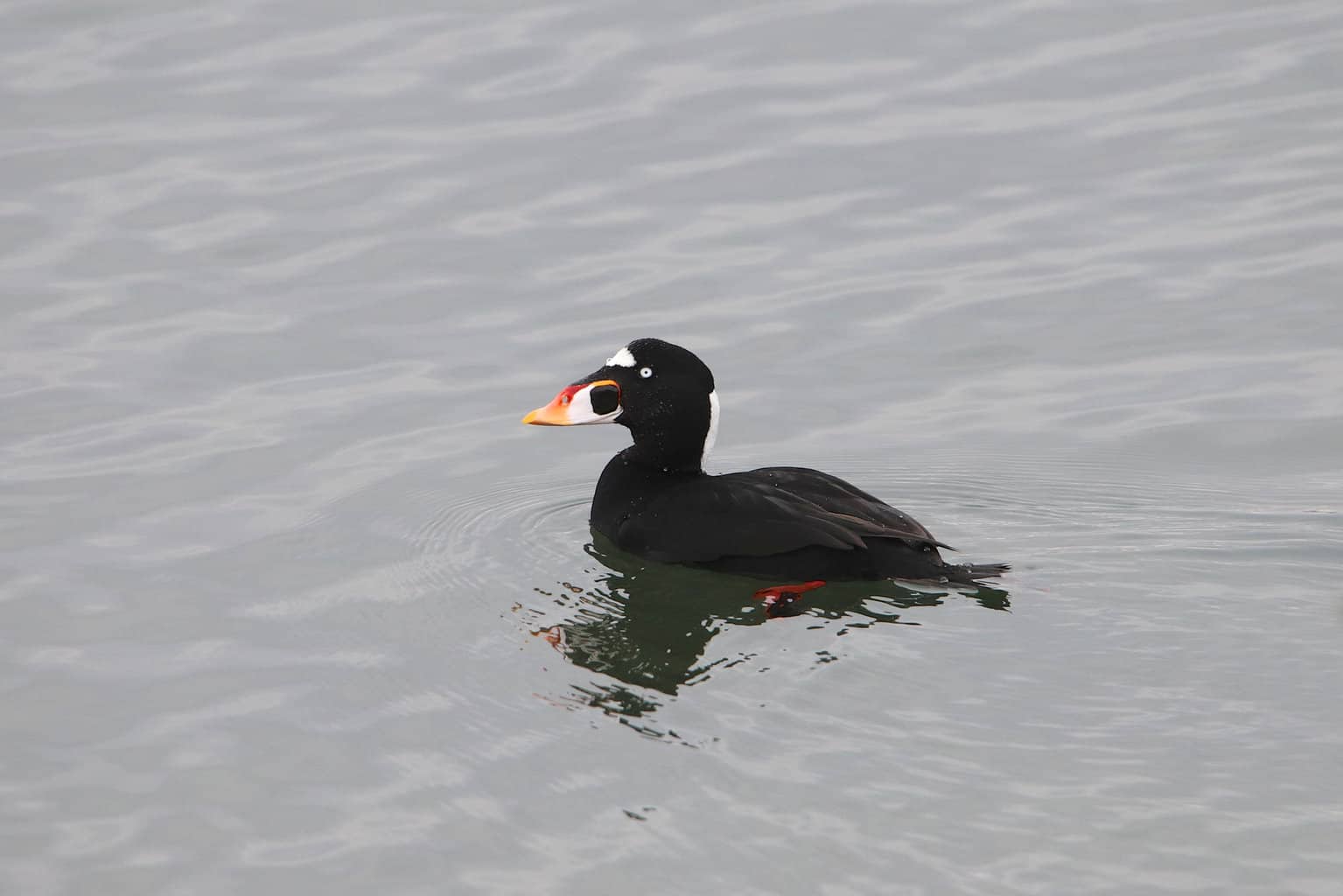
- Melanitta perspicillata
- Length: 17 – 21 in (43 – 53 cm)
- Weight: 35.27 oz (1000 g)
- Wingspan: 30 – 36 in (76 – 91 cm)
Surf Scoters winter along most coastal waters in the US, including New England. They don’t stray far from the ocean, although they will live along coastal bays and estuaries.
Surf Scoter are easy to identify, thanks to their huge, colorful knobbed bill and sloping forehead. The male is mostly black, but he has some white spots: one on his bill, and one on the base of his neck.
The female is smaller than the male, and her bill is plain instead of brightly colored. Her body is patchy and gray, with some white patches on her back and behind her eyes.
White-Winged Scoter (Sea Duck)
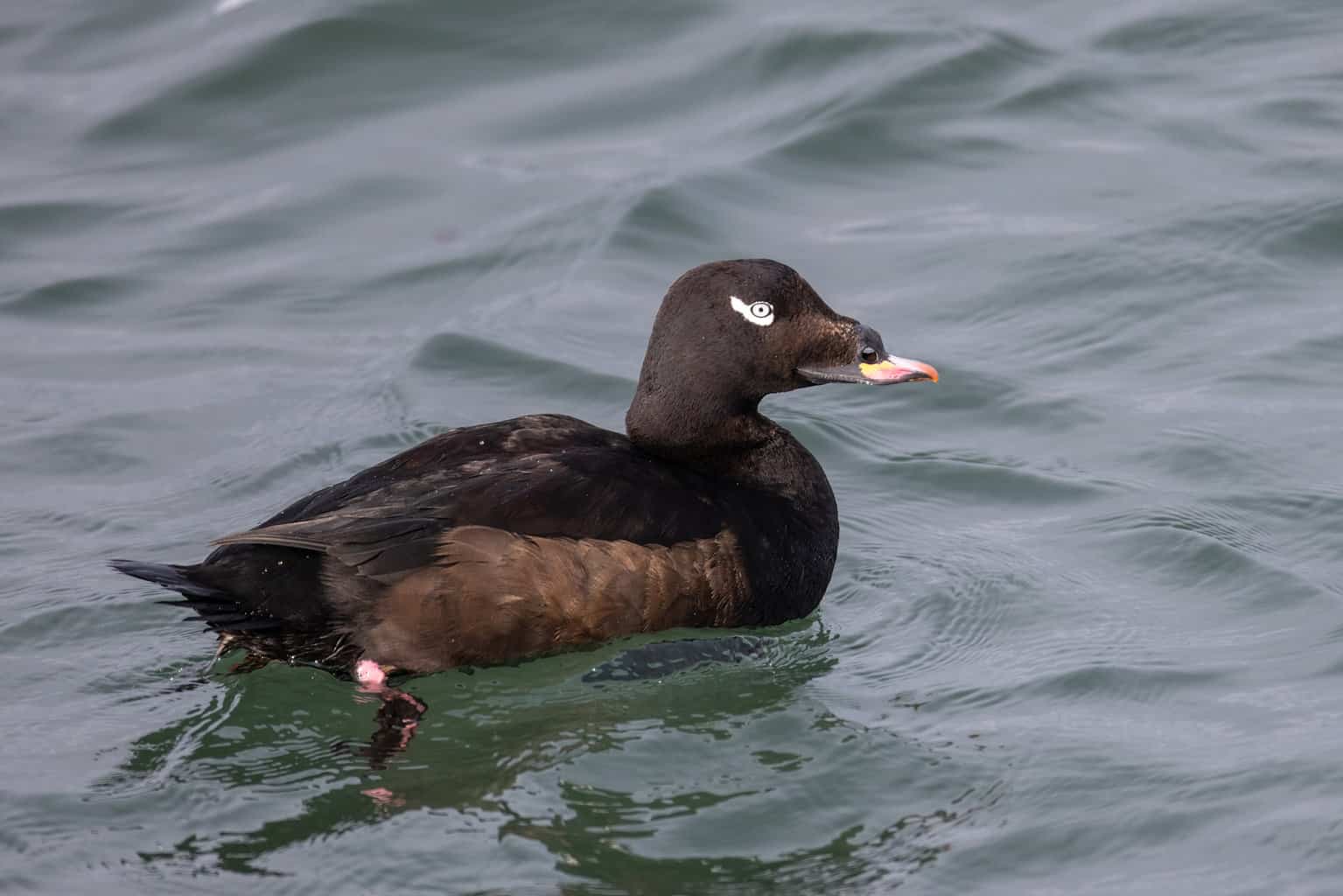
- Melanitta deglandi
- Length: 19 – 24 in (48 – 61 cm)
- Weight: 62.4 oz (1768 g)
- Wingspan: 33 – 41 in (84 – 104 cm)
White-Winged Scoters are migratory visitors in most of Maine, but they winter along the coast. They prefer the state’s open coastal waters, including sandy bays and inlets. They are drawn to shellfish beds with plenty of food.
Like other scoters, including Surf Scoters and Black Scoters, White-Winged Scoters have a thick, bulging bill. The male’s bill is bisected in black at the base and red near the tip. His body is almost entirely black, but he does have a long white stripe along his wings and a white “reverse comma” over his eyes.
Females look similar, but their overall coloring is slightly less intense. They have no markings on their eyes, but they do have a small white cheek patch.
Wood Duck (Dabbling Duck)
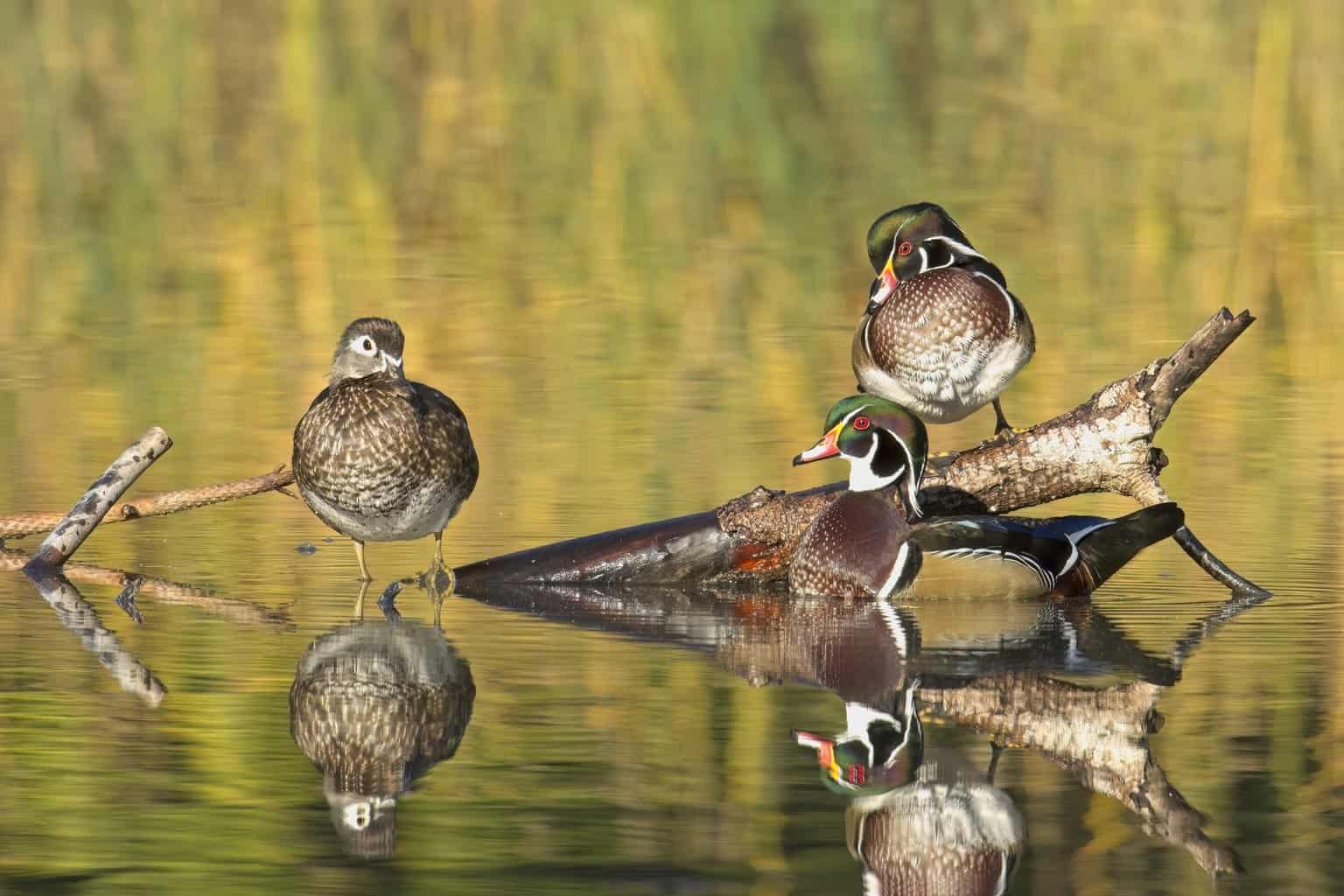
- Aix sponsa
- Length: 18.5 – 21.3 in (47 – 54 cm)
- Weight: 16.0 – 30.4 oz (454 – 862 g)
- Wingspan: 26.0 – 28.7 in (66 – 73 cm)
Wood Ducks spend the summer in Maine, hatching eggs in June and migrating by September. They nest in empty tree cavities. They are found in many different kinds of water during the summer, including ponds, lakes, rivers, streams, and marshes.
Male Wood Ducks are vibrantly colored. Their chestnut brown breast is dappled with tiny beige markings, and they have a crested, iridescent green head with black and white stripes. He also has white stripes on much of his body. Perhaps most striking is his bill, which has black, white, orange, and yellow in it.
Females lack such dramatic coloring. Their crests are small, and their bodies and heads are brown. They have lovely blue, white, and purple coloration on their wings.
Ready To Find Ducks in Maine?
Now that you know how many incredible ducks you have the potential to identify in Maine, are you ready to get started?
Whether you are visiting Maine or you live in the state, you can see some amazing wildlife and bird life here.
Our Guide to Birds in Maine will help you identify more than just ducks in the state. You can also find birds of prey, songbirds, hummingbirds, and many more interesting species.
If you’re ready to look for ducks, you will want to bundle up and gather your supplies, as most ducks are here in the winter.
We recommend a great notebook, a birding app or guidebook, a pair of standard binoculars or compact binoculars, and maybe even a spotting scope. Spotting scopes are especially helpful if you want to document the ducks you find with great digital photography.
We hope you have a great time as you search for ducks and more in Maine’s marshes, lakes, and waterways!

